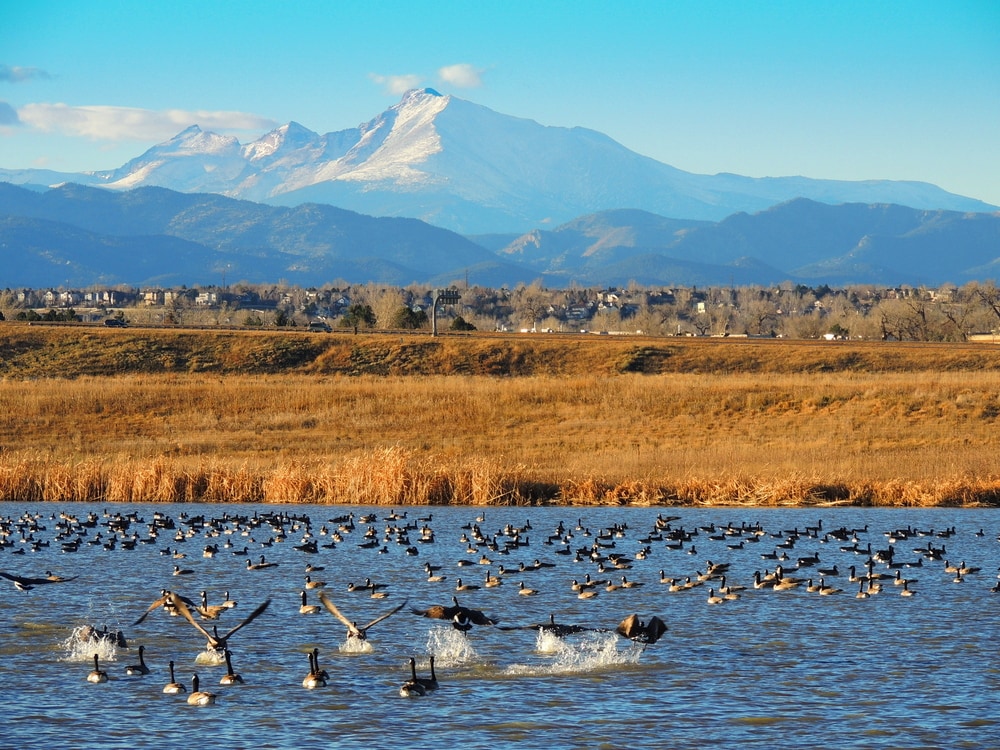
With so many mountain ranges covered in forests, surrounded by creeks, decorated with edible shrubbery, and a wildflower season unlike any other, it’s no wonder that more than 400 species of birds call Colorado home.
As we take flight over the Centennial State we’ll explore the birds that are permanent residents, including their local migration patterns, diet, nesting habits, sizes, coloring, and all the fun details that make these Rocky Mountain aerial gymnasts so captivating.
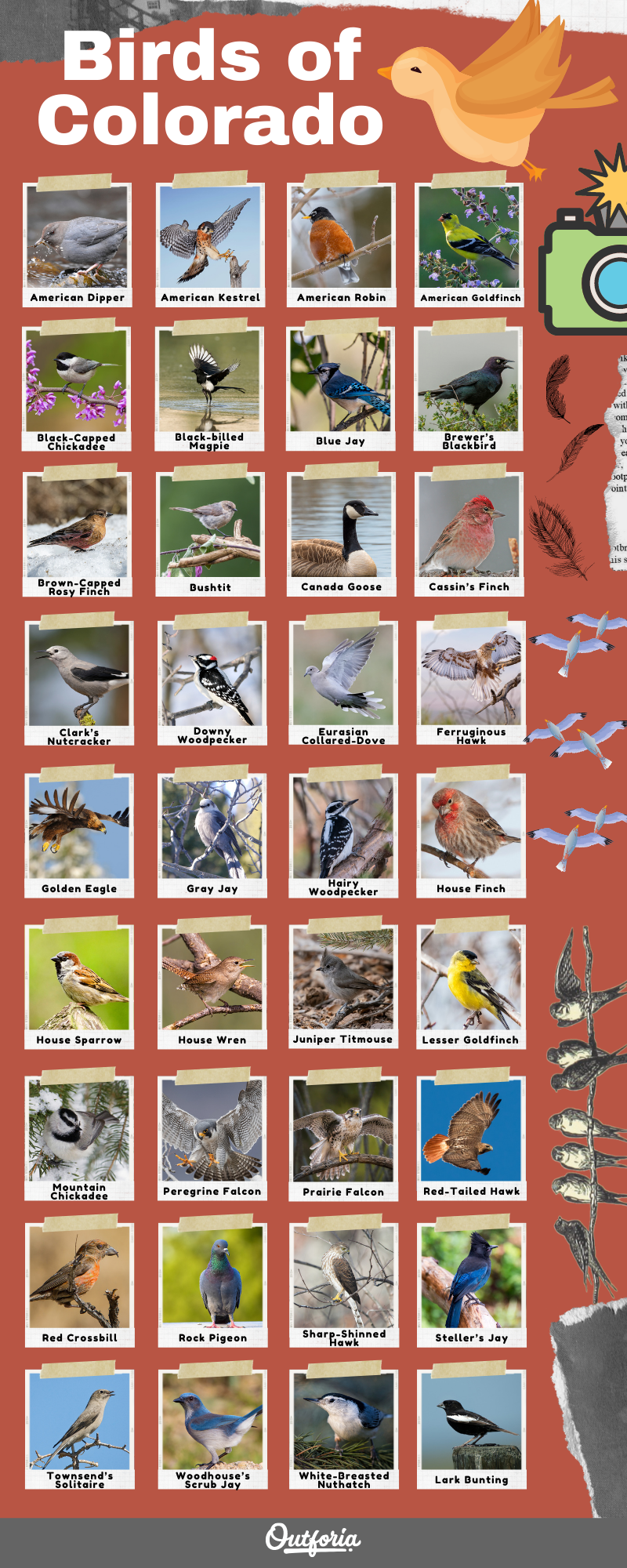
Share This Image On Your Site
<a href="https://outforia.com/birds-of-colorado/"><img style="width:100%;" src="https://outforia.com/wp-content/uploads/2022/01/Birds-of-colorado-infographics-01272022.png"></a><br>Birds of Colorado Infographic by <a href="https://outforia.com">Outforia</a>You May Also Like: Get To Know These More Than 25 Striking Types of Falcons with Photos, Facts, Infographics, and more!
36 Different Types of Colorado Birds
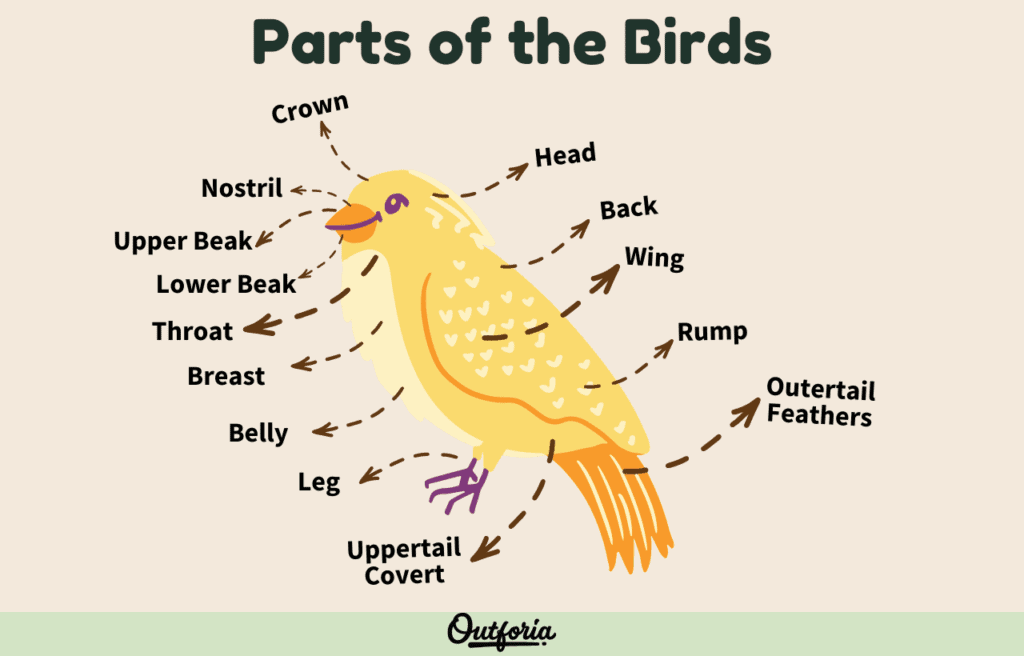
Before we continue let’s cover the basics. It’s always important to have a rudimentary understanding of what we are exploring. Though birds seem simple, they can be as complex as humans. Feel free to reference the photo above when we discuss size, features, and coloring.
Here’s a collection of beautiful birds who call Colorado home.
1. American Dipper (Cinclus mexicanus)
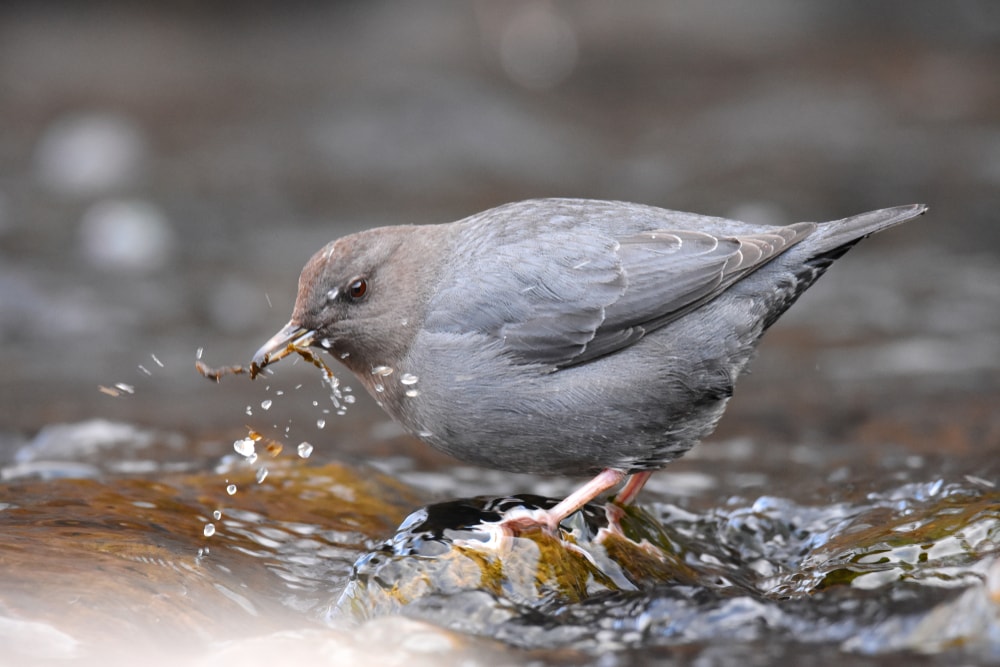
The Colorado American Dipper, formerly known as a Water Ouzel, is solid gray with a slightly lighter head and legs. It reaches a length between 5.5 and 7.9 inches (14 and 20 centimeters) and can weigh up to 2.4 ounces (68 grams). Its dark features help this bird blend in with the watery rock outcroppings of its habitat.
Its habitat is where it will feast on aquatic insects, bugs, and worms. Both male and female American Dippers will feed their nestlings for 18-25 days. This is when the young leave the nest. It’s common for this traveler to only migrate to lower elevations when streams freeze during the winter.
2. American Kestrel (Falco sparverius)
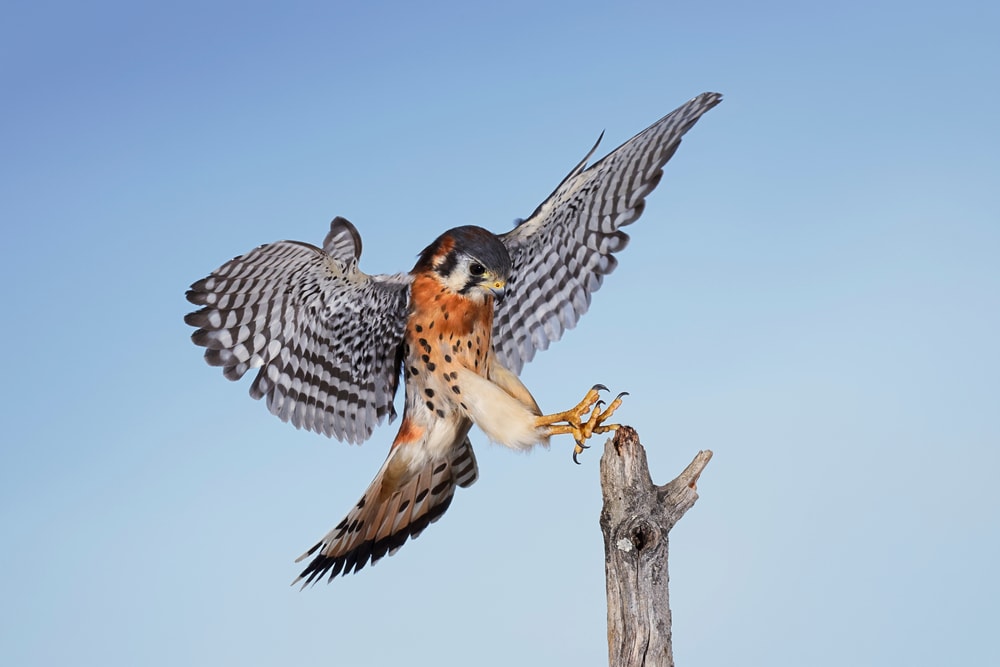
North America’s smallest falcon, the American Kestrel, ranges from 8.7 to 12.2 inches (22 to 31 centimeters) in length with a wingspan of 20 to 24 inches (51 to 61 centimeters). They’re brown spotted with black vertical stripes near their eyes and head and have a black band near the tip of the tail. Males have blue wings, while females’ wings are usually reddish-brown.
Its diet consists of insects, small rodents, songbirds, amphibians, and even small bats. They prefer open habitats that offer plenty of cavities found in trees, buildings, or rock formations for nesting. Look for kestrels scattered throughout Colorado year-round.
3. American Robin (Turdus migratorius)
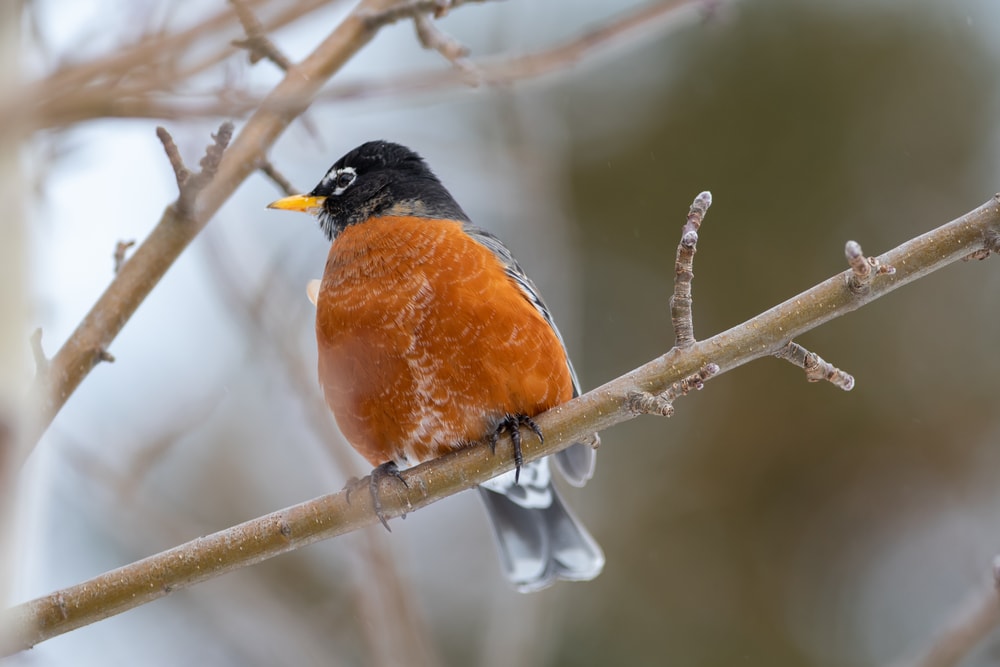
American Robins can grow between 9 and 11 inches (23 and 28 centimeters) in length. They’re gray on top and their bellies are brick red. The head and tail are black in males and dull gray in females. Their daily diet has them feasting on berries, worms, and caterpillars.
They will make homes in cities, towns, lawns, farmland, and forests. They are rarely found in well-watered lowland suburbs. In winter, flocks gather in wooded areas where trees or shrubs have good crops of berries.
Global warming has caused this once migratory bird to stay in Colorado all winter. They travel to lower elevations during the coldest months, returning to high elevation by Spring to nest.
4. American Goldfinch (Spinus tristis)
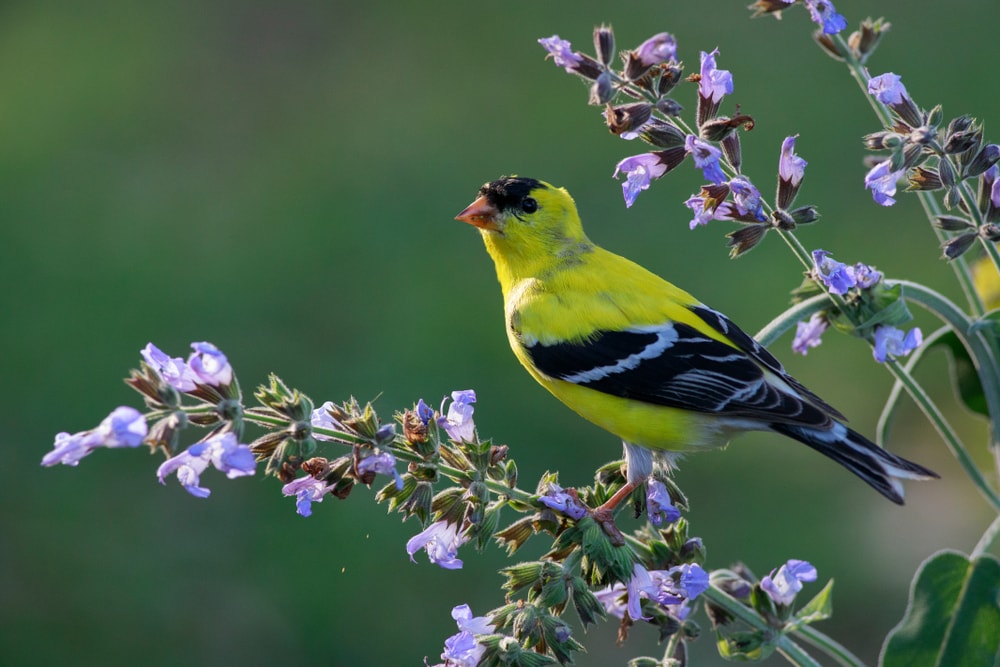
At 4 1/2 to 5 inches (11.4 to 12.7 centimeters) in length, the American Goldfinch lives in Colorado all year. An adult male is a bright yellow with a white undertail, a black forehead, with white stripes on its black wings and tail. A female goldfinch and males during the winter tend to be duller and grayer.
They enjoy eating seeds, but thistle makes up the majority of the American Goldfinch’s diet. They may also eat insects or aphids and feed regurgitated seeds to their young. It isn’t rare for both parents to bring food to their young.
After 12 to 17 days of living at home, the young birds leave the nest. The parents, however, continue to feed fledglings for a few weeks. American Goldfinches are commonly found in brushy and weedy habitats at the edges of fields, rivers, and hedges.
5. Black-Capped Chickadee (Poecile atricapillus)
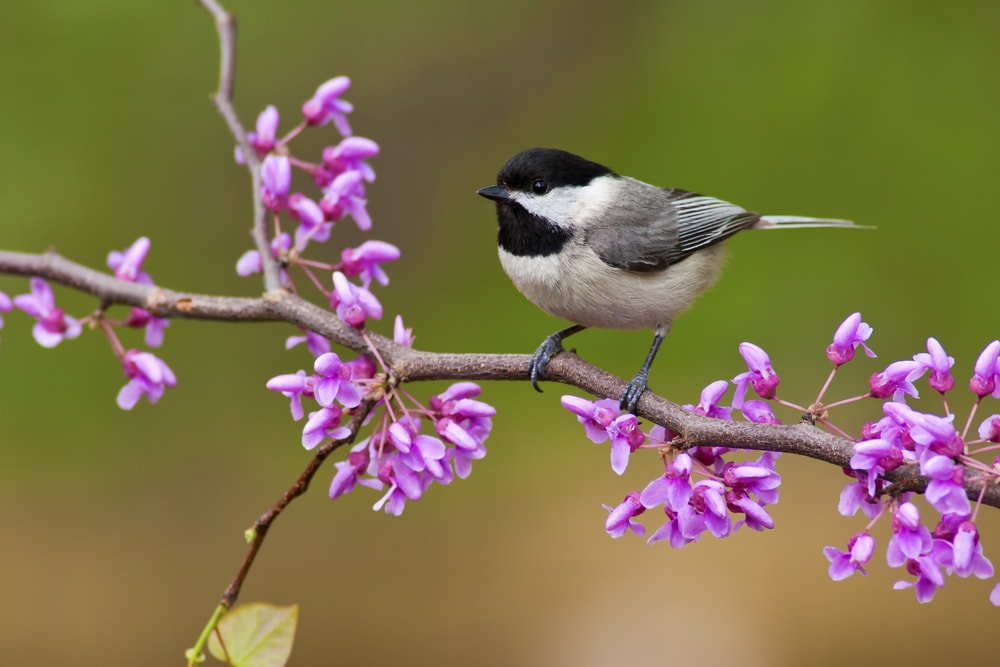
With its black cap and throat, white cheeks, gray back, dull-white underparts, it’s easy to mistake Colorado’s Black-Capped Chickadee for the Carolina Chickadee. This tiny bird reaches a length between 4 ¾ and 5 ¾ inches (12 and 14.6 centimeters).
Like a lot of small birds, their diet includes seeds, berries, insects, and invertebrates. Male and female chickadees excavate nest cavities in rotting wood or build nests in abandoned woodpecker cavities. Females build the nest and can fill it with up to 13 eggs. The male brings her food while she incubates the eggs, but both parents raise the young.
Look for these chickadees in deciduous and mixed deciduous-evergreen forests and near forest edges. They are most commonly found near willows and cottonwoods. They like to build nests in the snags of alder and birch trees.
6. Black-billed Magpie (Pica hudsonia)
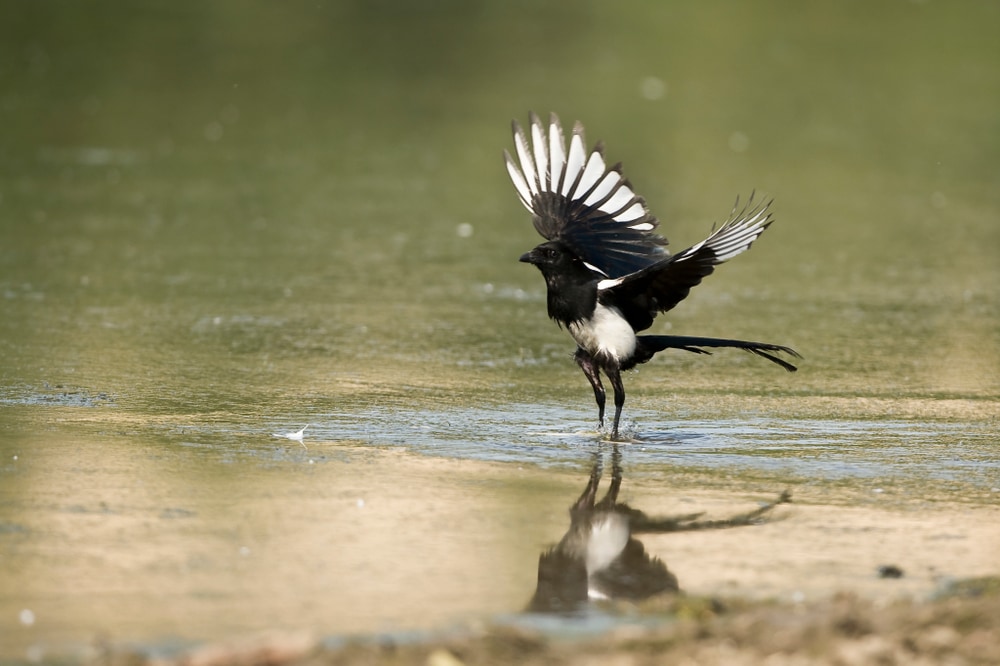
The vocal Black-billed Magpie is generally a permanent resident, only migrating to lower elevations during winter. They are related to crows, ravens, and jays. They have white bellies and shoulder patches and their wings flash white in flight. The feathers of the tail and wings are stunning iridescent, that shimmer a bronze-green or purple.
These magpies average 19 inches (48 centimeters) in length and can weigh half a pound. These birds will consume insects, grasshoppers, bugs and all kinds of caterpillars, and even the younglings of other birds. They are found near water, in moderately open areas with scattered trees and thickets. Their preferred habitat is in foothills, ranches, farms, and sagebrush.
7. Blue Jay (Cyanocitta cristata)

The Blue Jay has made our list due to its unpredictable migratory behavior. Some head south one year, then north the next year, and sometimes stay put where they are. This makes it confusing for researchers to work out if/why they migrate when they do.
This beautiful indecisive bird is one foot in length with vibrant blue coloring and some white and black markings in the wings and tail. Most of their diet is composed of acorns, nuts, and seeds, but don’t be shocked if you also see them munching on caterpillars, grasshoppers, and beetles.
Its habitat is diverse, ranging from pine woods to spruce-fir forests. It favors mixed woodlands with oaks and beech trees and builds its nests in thick branches of deciduous or coniferous trees.
8. Brewer’s Blackbird (Euphagus cyanocephalus)
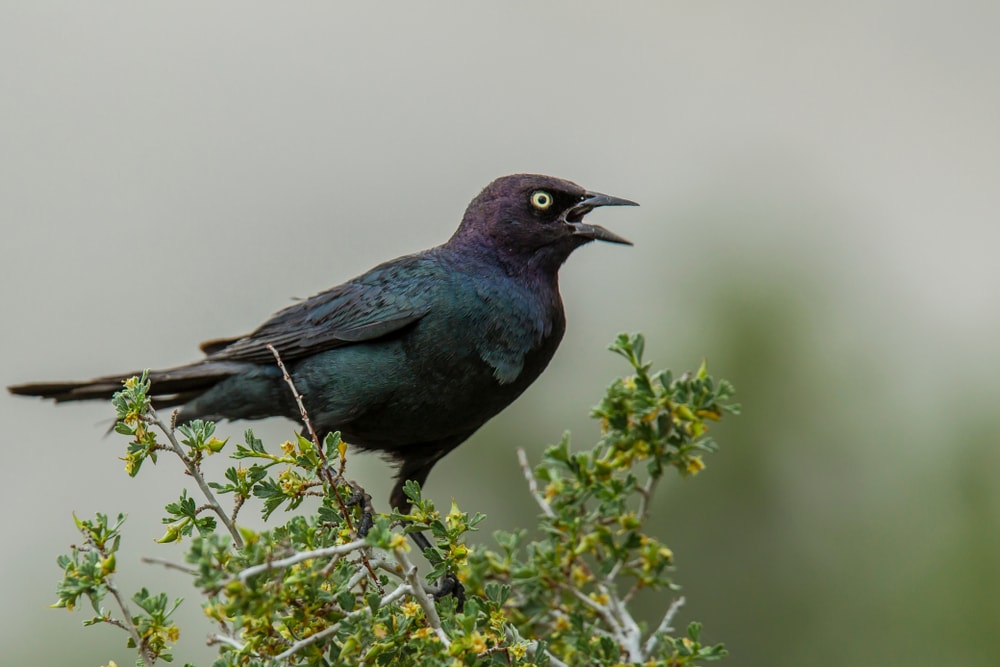
The Brewer’s Blackbird is around 8 to 10 inches (20 to 25 centimeters) in length. Males are solid black with a purple-blue iridescent head and yellow eyes. Females tend to be grayer with dark eyes. They typically live in meadows, grasslands, and areas bordering bodies of water. They can be found in elevations of up to 10,000 feet (3,048 meters).
Don’t look up as these dark birds can easily blend in with their habitats. However, you might be able to spot them foraging on the ground, eating seeds, grains, insects, or small mammals. They usually nest 20 to 40 feet (6 to 12 meters) above ground in trees but may nest on the ground, in shrubs, or in tall grass.
9. Brown-Capped Rosy Finch (Leucosticte australis)
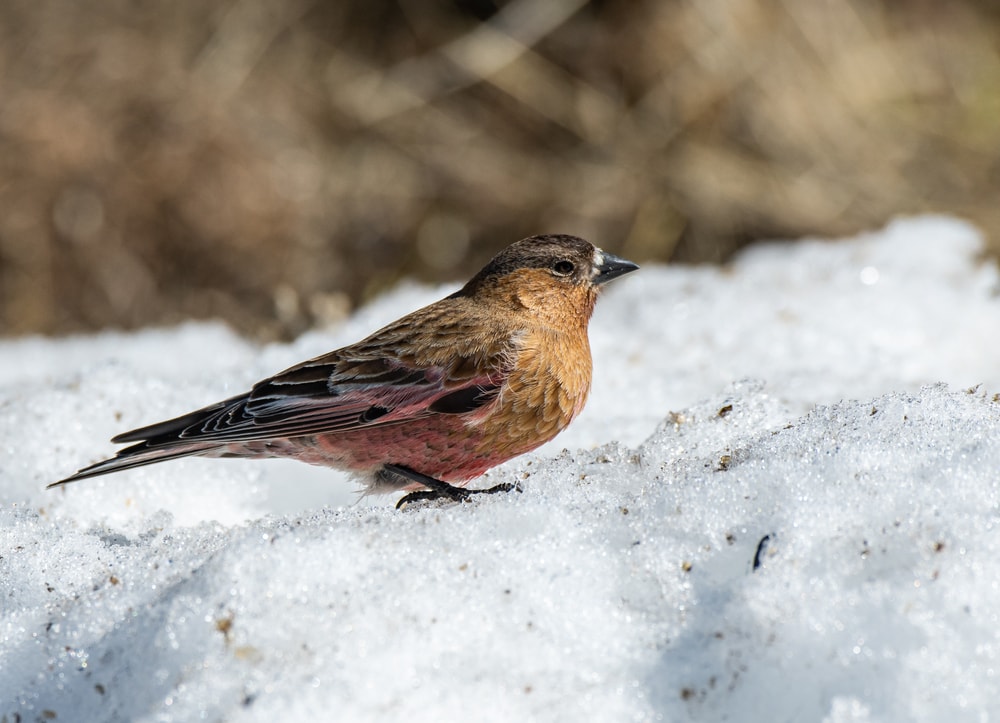
With a maximum length of 6 ½ inches (16.5 centimeters), the Brown-Capped Rosy Finch is a black-billed light brown bird with pink-red coloring all over. It has a black forehead and a brown head, breast, and back.
It prefers to settle down in high alpine areas near remote glaciers and snowy meadows. Brown-capped Rosy-Finches sometimes use abandoned mines to build their nests, using grass, feathers, and fur to line their nests. They will feed on seeds and insects. In winter, they fly in flocks into forested habitats at lower elevations.
10. Bushtit (Psaltriparus minimus)
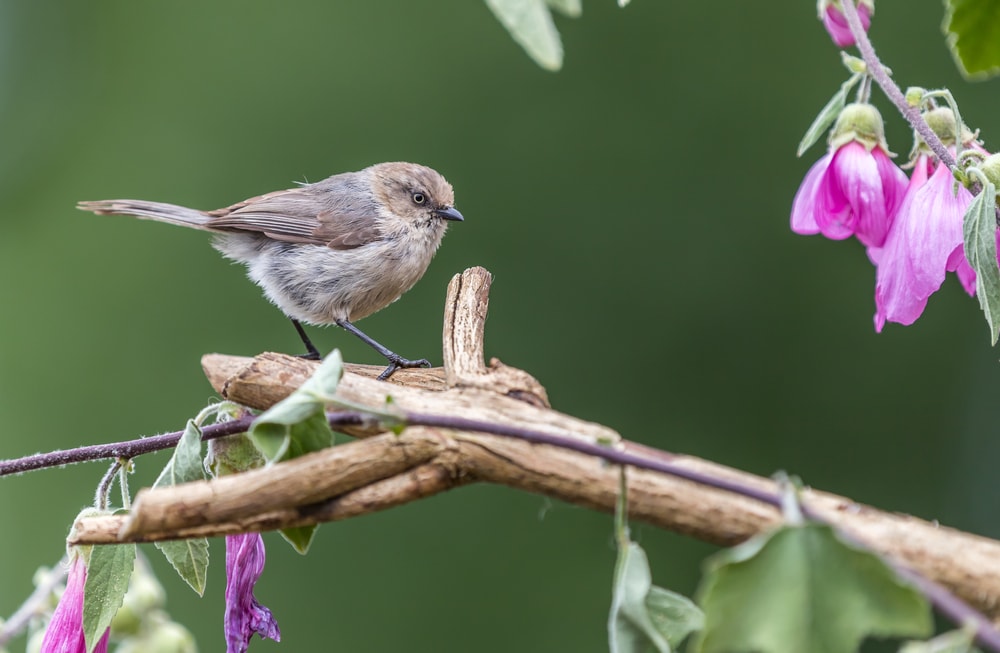
What an interesting name. Between 3 3/4 to 4 inches (9.5 to 10 centimeters) in length, this mostly gray small bird takes pride in its long tail and brown ear patches. With a name like Bushtit, it needs all the confidence it can get. Luckily, it’s adorable!
It weighs in between .1 and .2 ounces (2.8 to 5.6 grams). It nests in trees and bushes, favoring the taste of sunflowers, worms, peanuts, and even suet blends from traditional home bird feeders. They prefer woodland or scrub habitats with deciduous or mixed deciduous and coniferous trees. They are also found in areas bordering bodies of water, as well as in suburban parks and gardens.
11. Canada Goose (Branta canadensis)
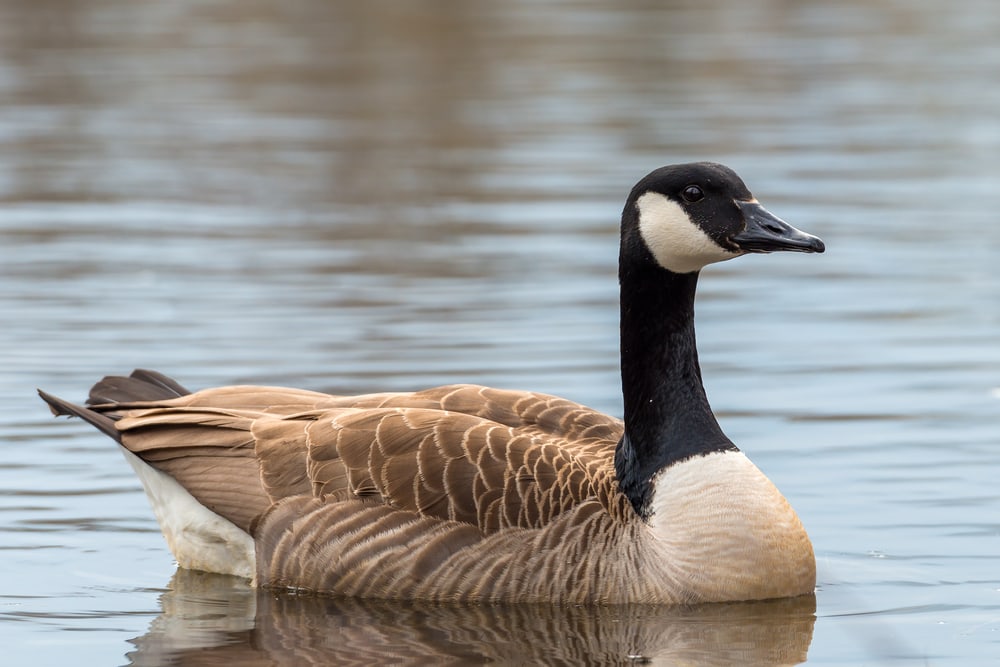
No worries. We’re still in Colorado. Canada geese reside year-round throughout most of Colorado and you will typically find them in large numbers. It’s easily identified by its large brown body, black head and neck, white cheeks, white under its chin, and the wiggle of its short tail as it walks.
This wild goose is roughly 35 to 45 inches (89 to 114 centimeters) in length. When flying across the Rocky Mountain skies, you can spot them by the V-formation the gaggle (a group of geese flying) creates. It is believed that this formation helps them conserve energy. After all, they’ve been documented covering 1,500 miles (2,414 kilometers) in 24 hours.
Lakes, ponds, marshes, and fields are the preferred environment for Canada geese. However, they are lured into golf courses, airports, and parks due to their attractive habitat. These geese are primarily plant eaters. Their nests can be found on the ground near water. Please do not disturb.
12. Cassin’s Finch (Haemorhous cassinii)
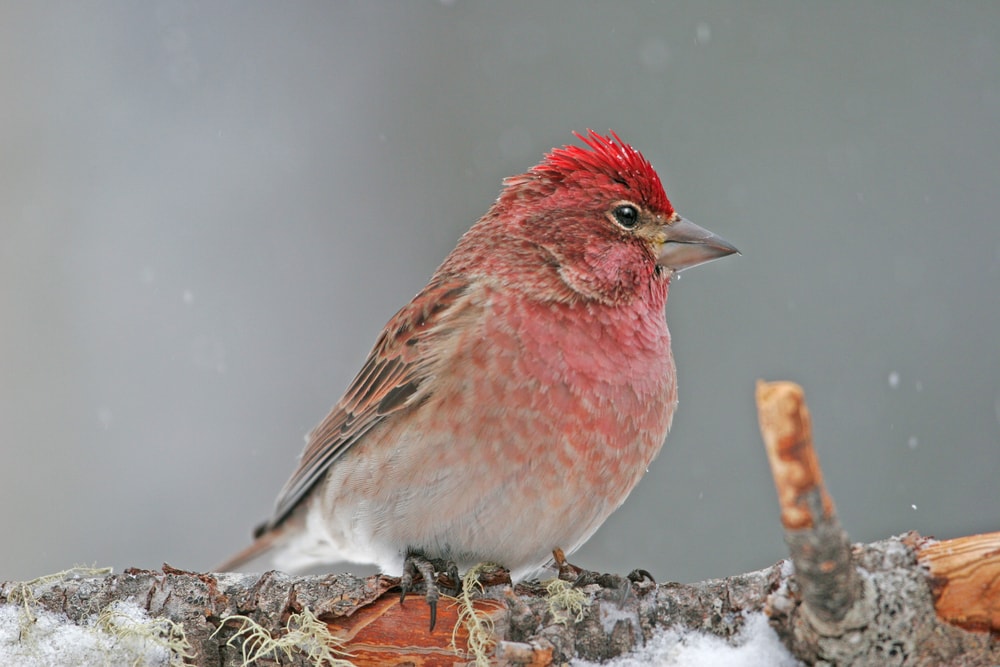
These pink-red birds reach a length of 6 to 6 ½ inches (15 to 16.5 centimeters). Females show no red feathers, however. But they pick the site for their nest and do most of the building. Their color is beautiful, but what’s interesting about them is that Cassin’s finches will join different species of finches during the winter. They come together to help each other search for food and survive the harsh winters.
Though the Cassin’s Finch can be found throughout Colorado, they are most common in the western and central areas of the state. If you reside in Colorado, don’t be surprised if these cutie pies visit your gardens. Especially during winter when food is scarce. They love sunflower seeds and insects.
13. Clark’s Nutcracker (Nucifraga Columbiana)
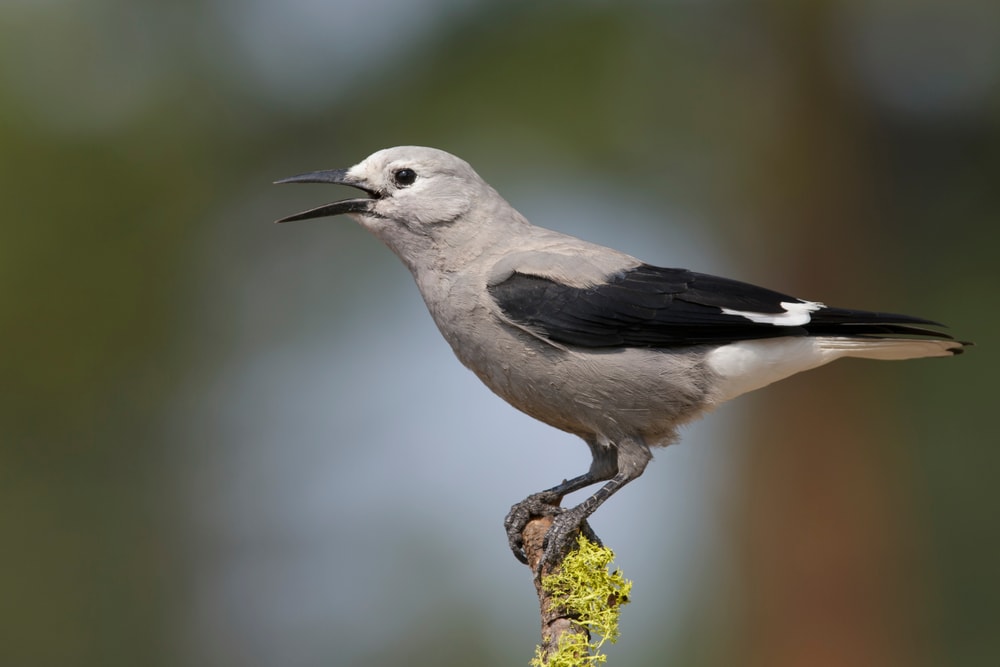
Not to be mistaken for a Gray Jay, the Clark’s Nutcracker is a medium-sized bird with a long, sharp bill. Its body is mostly gray and has black wings and tail with some white. Pine seeds are this bird’s primary source of food. They also eat other seeds, nuts, berries, insects, eggs, and nestlings of other birds, and if the opportunity arises, carrion is not turned down.
It’s easy to find them in open coniferous forests anywhere from 3,000 to 12,000 feet (914 to 3,658 meters). They are often seen in stands of whitebark or pine with a nearby water source. They become more abundant in higher elevations during warmer weather. In the fall, they travel to lower elevations in search of forests that have the most available seeds.
14. Downy Woodpecker (Dryobates pubescens)
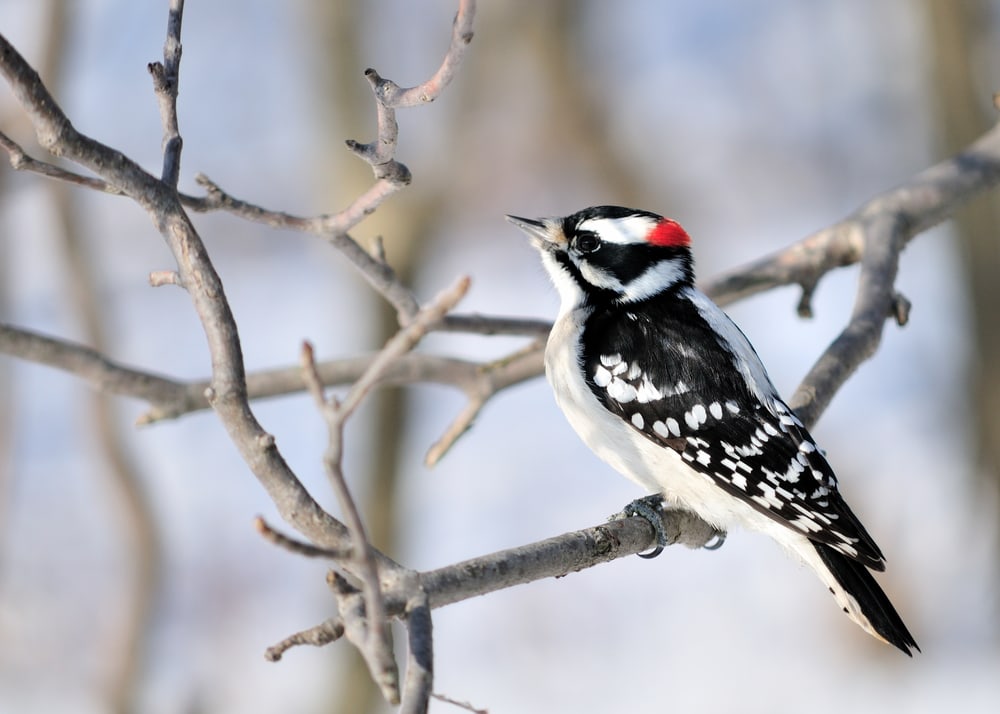
Barely weighing in at an ounce, the Downy Woodpecker is one of 12 species of woodpeckers found in Colorado. It builds its nest at incredible heights in dead trees. Both sexes will take turns incubating eggs for 12 weeks.
The Colorado Rocky Mountains provide the ideal habitat for these birds. They can be found along river beds or thick forests and aren’t generally found in heavily populated areas. They find insects, spiders, scorpions, mites, ticks, centipedes, and millipedes most tasty. As well as bird feeders.
15. Eurasian Collared-Dove (Streptopelia decaocto)
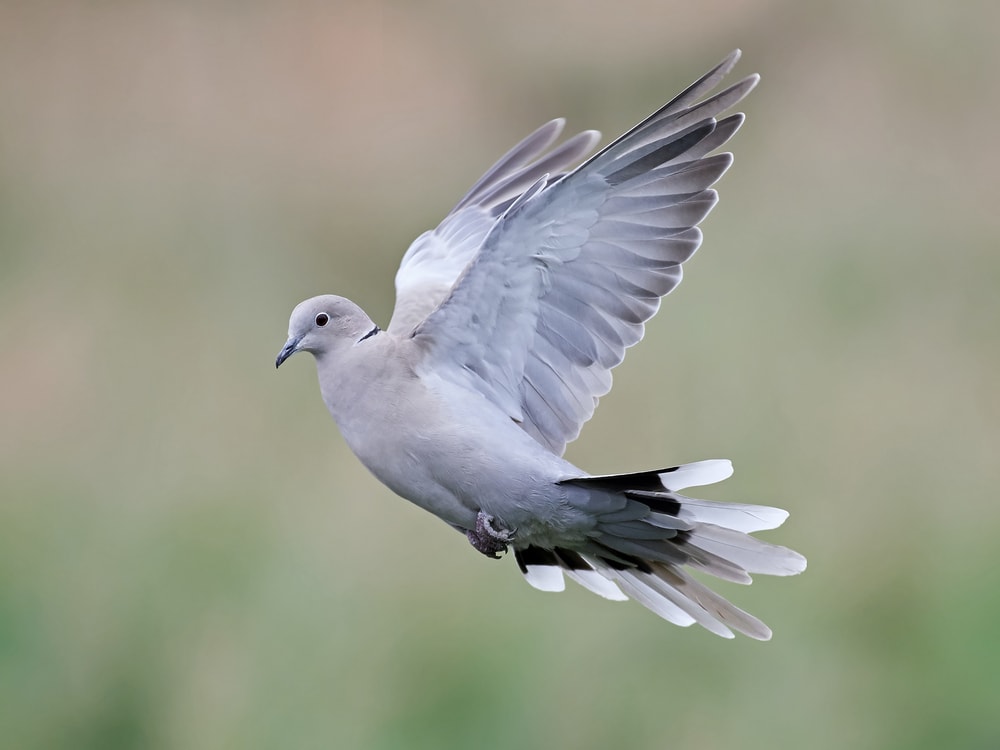
The original Bahamian Eurasian Collared-Dove found its way northwest and made a permanent home in Colorado. It’s 13 to 14 inches (33 to 35 centimeters) in length, making it larger than a Mourning Dove. It has gray-brown coloring with hints of pink, especially on the chest, and a distinguishing black collar marking on the nape.
They don’t like to work too hard for their food, so they are often found in well-developed areas and near homes where the food is easily available. They thoroughly enjoy seeds and grains. They also don’t like the company of other birds.
16. Ferruginous Hawk (Buteo regalis)
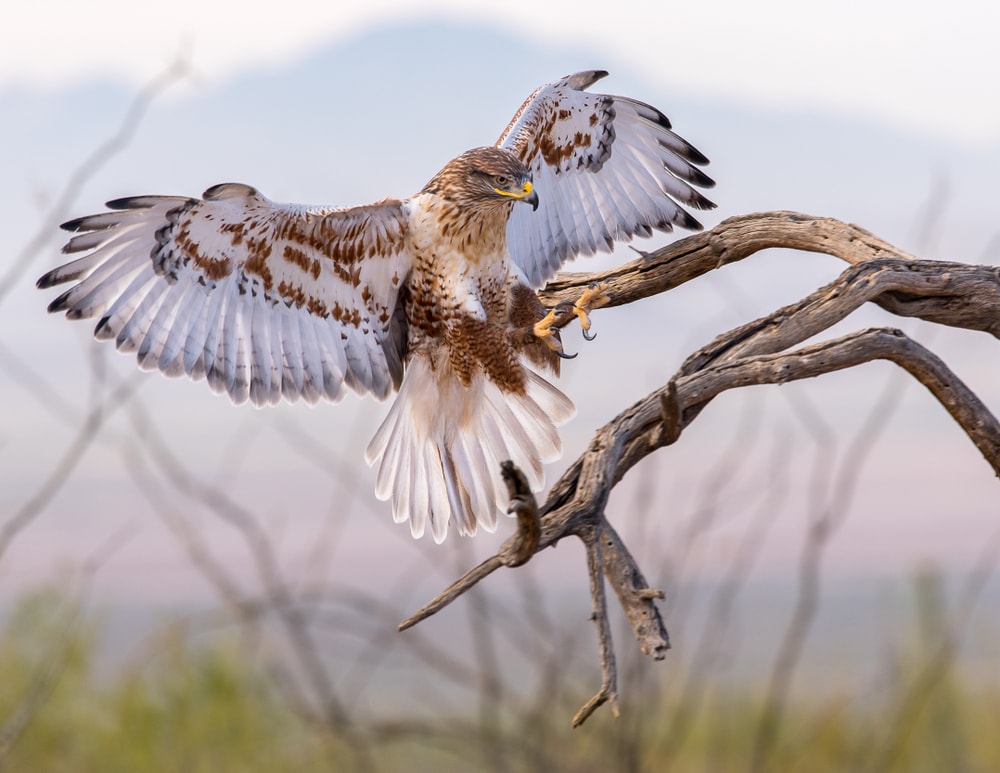
The ferocious Ferruginous Hawk’s body is completely covered in feathers except for its beak. Its chest and the under part of its tail are white. Adults have a rusty color on their back, shoulders, legs, and tip of the tail.
These raptors commonly prey on prairie dogs, ground squirrels, rabbits, gophers, and other mammals. Keep the kitties inside! Sometimes they will also hunt birds, reptiles, and large insects.
Ferruginous Hawks live year-round on the eastern plains of Colorado, where they will nest, using the same nest year after year. The female will lay two to four eggs per brood. Once they hatch, the babies will spend five to six weeks in the nest before they fledge. Pairs fall in love and stay together until death do them part.
17. Golden Eagle (Aquila chrysaetos)
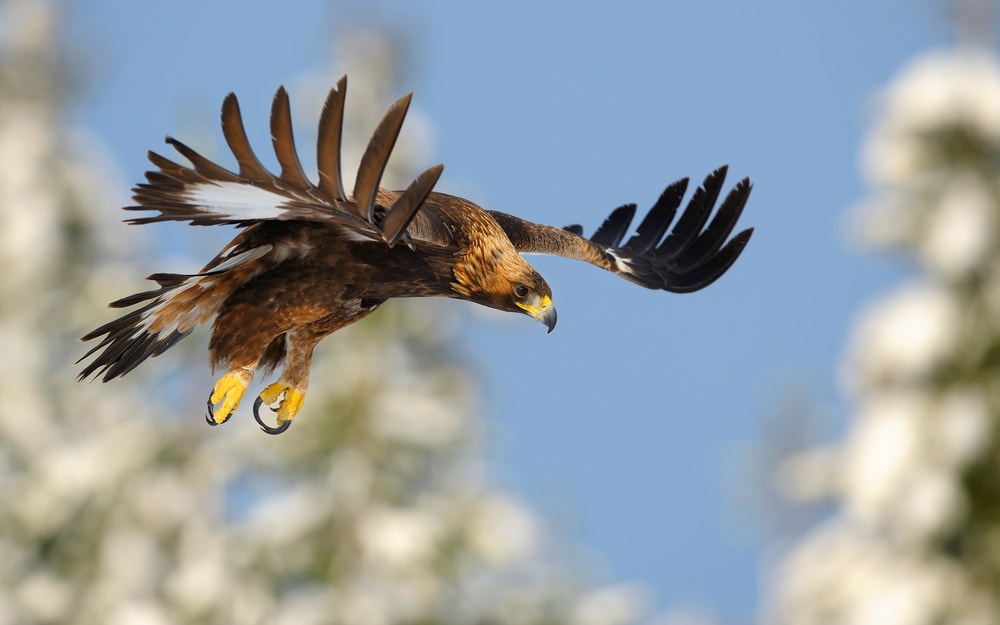
Eagles have been capturing our undivided attention for centuries. Golden Eagles are no exception to this fact. These majestic birds of prey are experts in everything they do. They nest on cliffs or in trees. Reaching lengths between 26 and 40 inches (66 and 102 centimeters) and a wingspan of up to eight feet (2.4 meters), makes them require large areas to live in and ample space for foraging.
They get their name from the golden color on the back of the crown and nape. Both sexes have similar dark brown plumage with some gray on the inner wing and tail. Watch out for that 2-inch (5 centimeters) beak and almost 2.5-inch (6.4 centimeters) talons. Make sure you run for cover if you see one flying overhead.
Habitat use includes alpine tundra, pine forests, woodlands, sagebrush, grassland, and agricultural landscapes. In Colorado, golden eagles breed primarily in mountain habitats in the west and canyon habitats in the southeast.
18. Gray Jay (Perisoreus canadensis)
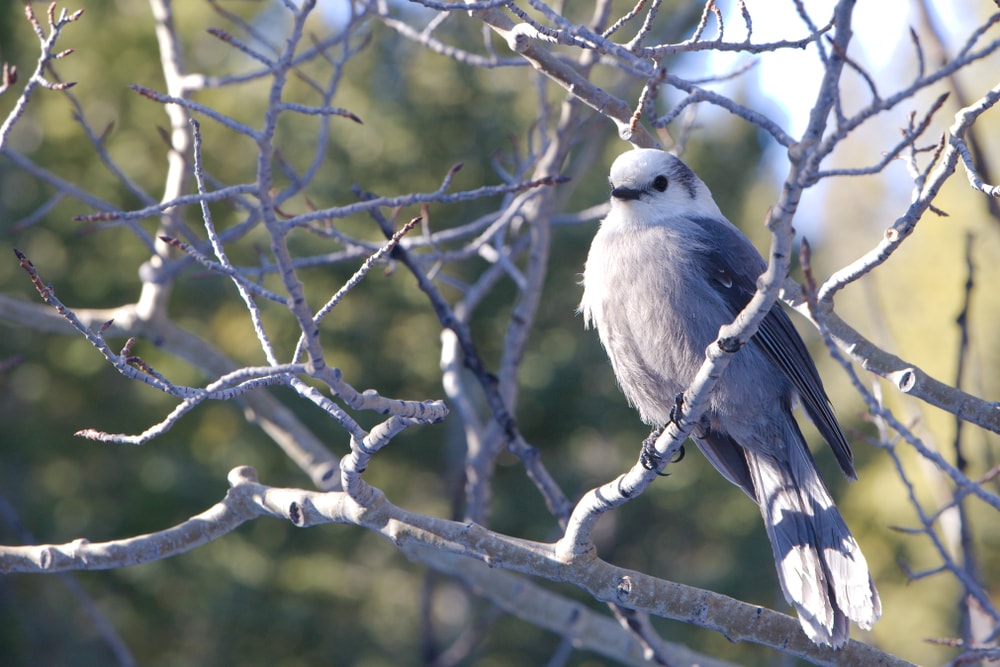
These gray-colored birds blend in perfectly when perched on leafless aspen trees. The gray is dark on top and light gray below. The black on the back of the head forms what looks like a partial hood. The average Gray Jay is between 11 and 12.25 inches (28 and 31 centimeters) and weighs roughly 2.5 ounces (71 grams).
The Gray Jay makes its home in boreal and subalpine forests but other tree species such as aspen, white birch, balsam fir, sugar maple, lodgepole pine, jack pine, red spruce, Engelmann spruce, Sitka spruce, eastern white cedar, yellow cedar, alpine fir, amabilis fir, and mountain hemlock have all been found in its habitat.
This talented bird will snatch flying insects in mid-air. With a varied diet, it seldom struggles to find food. Between invertebrates, amphibians, small mammals, nestlings of other birds, chickadees, berries, carrion, and fungi one can say that their options are endless.
19. Hairy Woodpecker (Dryobates villosus)
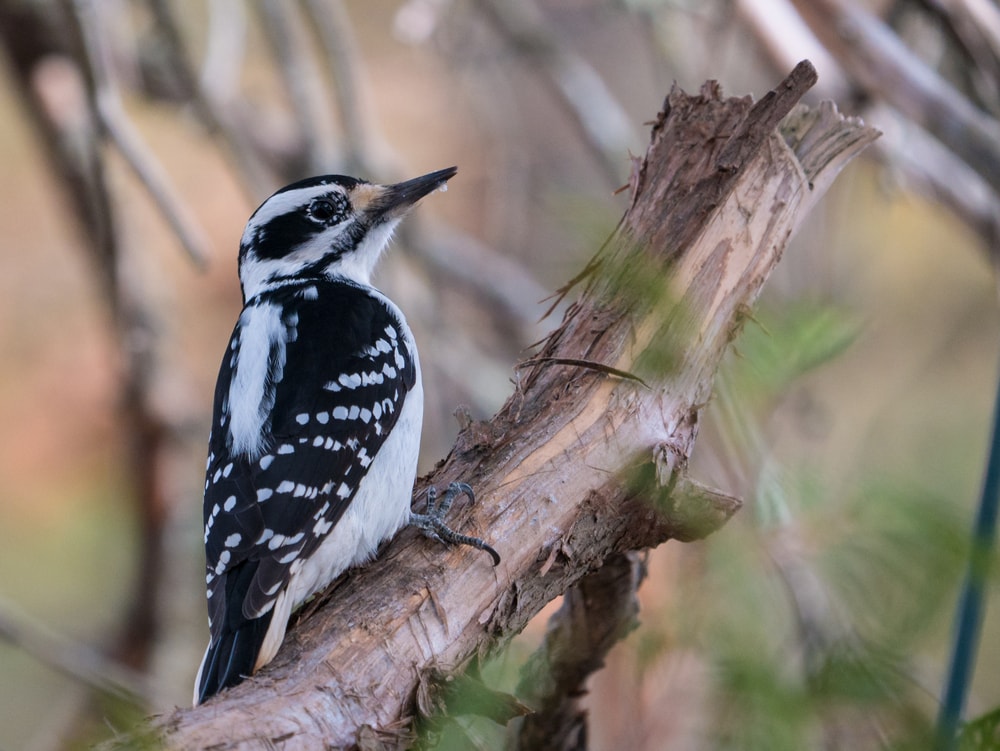
It’s easy to mistake the Hairy Woodpecker for its distant relative, the Downy Woodpecker. Spanning 15 inches (38 centimeter) in length and up to 3.4 ounces (96 grams) in weight, this tree dweller loves its wood-boring insects and tree sap.
These birds’ nests can be 5 to 30 feet (1.5 to 9.1 meters) off the ground in large trees that allow for deep hollows. Look for this woodpecker lurking around forest fire sites and rivers for insects to eat. It spends most of its days hunting bugs.
20. House Finch (Haemorhous mexicanus)
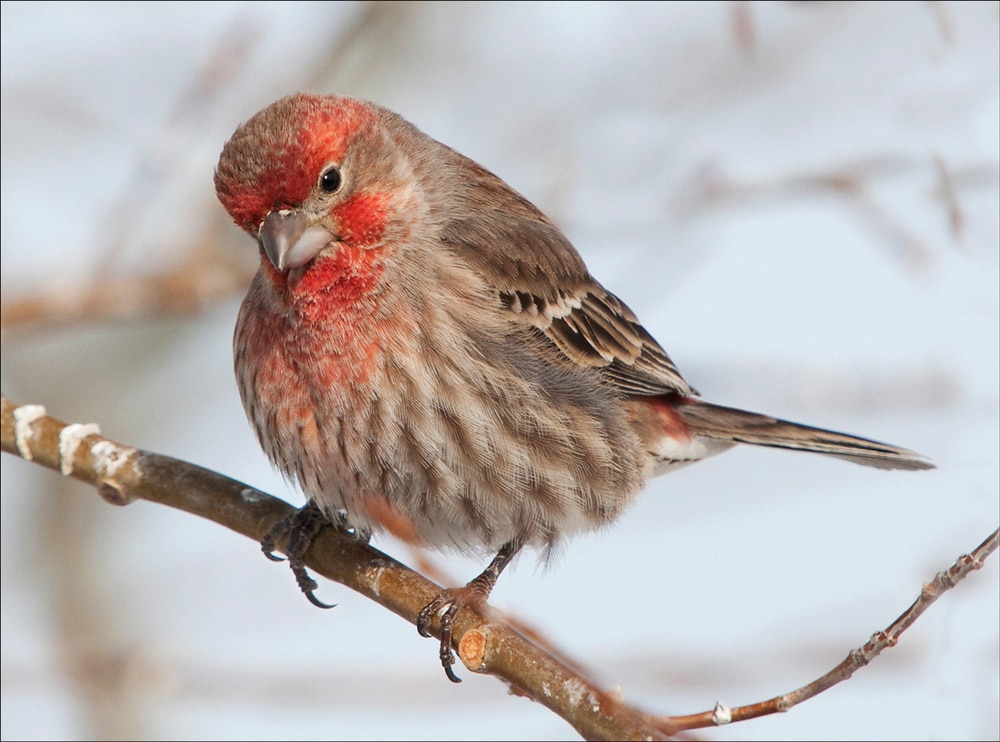
Similar to Cassin’s Finch, the House Finch lives in Colorado all year round. Male House Finches have bright red plumage and the females are covered in browns. They weigh between 16 and 27 grams.
Seeds are their main source of food. The most popular seed for them is the black oil sunflower seeds, some flower buds, cherries, and thistle. These birds forage both on the ground and in trees. You can find House Finches nesting in deciduous and coniferous trees, on cacti, old woodpecker holes, and rock ledges, and in or on buildings.
21. House Sparrow (Passer domesticus)
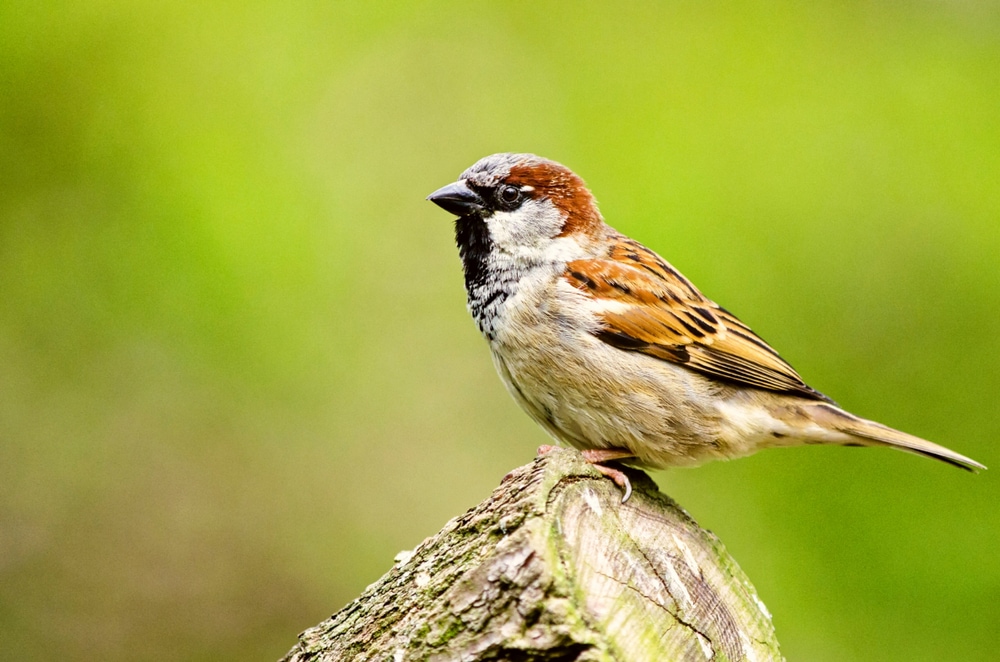
Another tiny yet spectacular bird has made it on our list of Colorado permanent residents. The House Sparrow is 5 to 6 ½ inches (13 to 16.5 centimeters) in length. Males have a black throat, white cheeks, and chestnut nape. Females, like their young, are streaked dull brown on top and are white underneath.
This little songbird is more commonly found in cities and farms than in natural environments. The primary diet consists of seeds but sometimes insects and weeds. Both sexes partake in the nest-building process, typically in tree cavities, holes in buildings, rain gutters, and abandoned nests of other birds. When nesting sites are scarce, they will nest on tree branches.
22. House Wren (Troglodytes aedon)
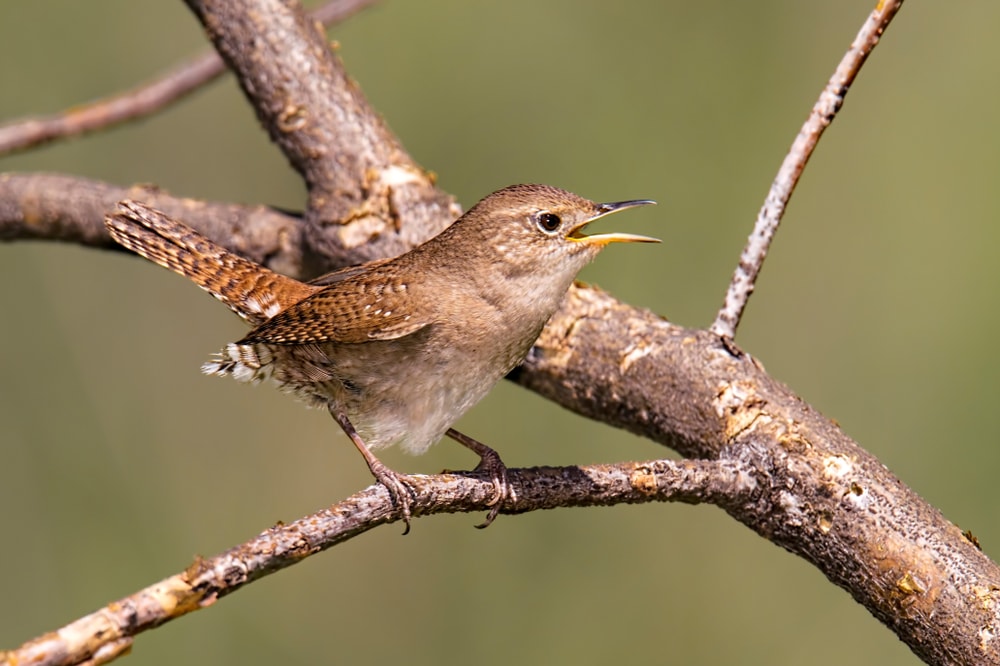
House Wrens are one of the smallest wrens in Colorado, growing about five inches. They’re brown, small, and compressed, with a flat head and a long, slightly curved beak. They zip through the air while hunting insects.
Their choice of dwelling is between open woods, thickets, towns, or gardens. But will breed in suburbs, orchards, woodlots, open forest, streamside groves, and mountain pine-oak woods to name a few. As with most of its kind, House Wrens eat mostly insects, but worms are part of their diet.
23. Juniper Titmouse (Baeolophus ridgwayi)
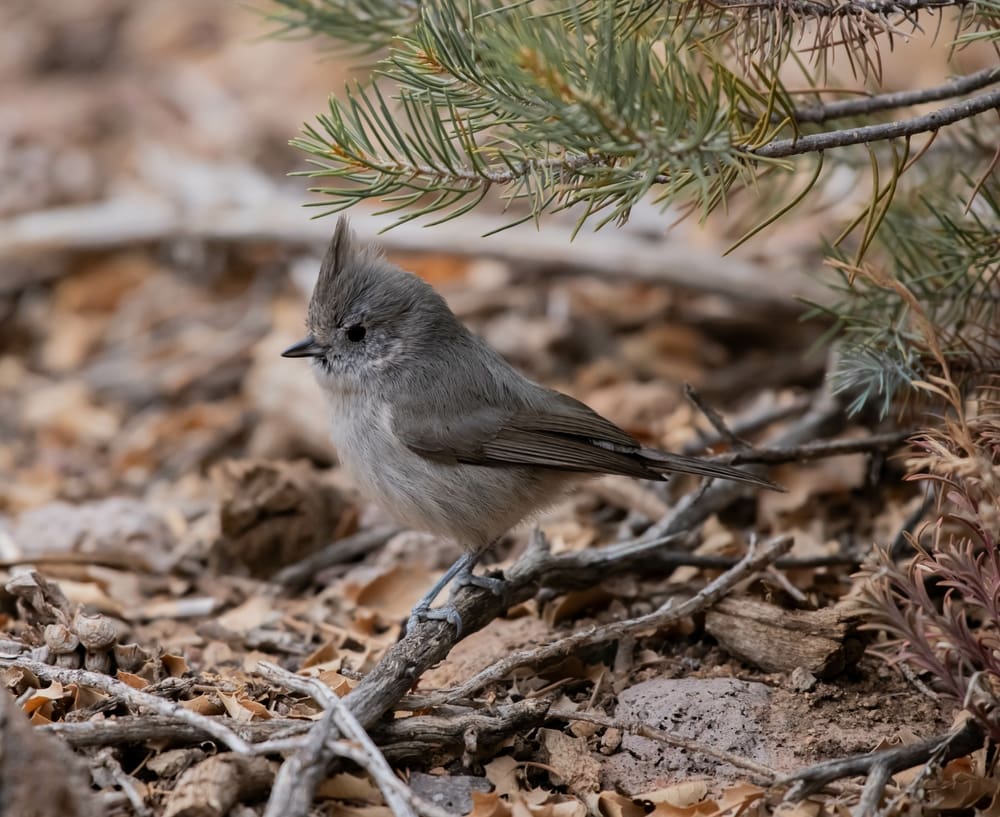
Gray seems to be the dominating bird color thus far as proven by the Juniper Titmouse. However, this gray-colored bird differs as its gray is pretty bland and with some darker shades speckled around its face. Juniper Titmice prefer to nest in organic cavities in dead trees or stumps, or old woodpecker holes.
Its preferred dinner consists of insects and spiders. Yum! Don’t be alarmed if you catch this bird hammering seeds against branches. It’s only trying to open them. Yeah, they eat seeds too, as well as berries and acorns. It forages on foliage, twigs, tree trunks, branches, and sometimes on the ground.
24. Lesser Goldfinch (Spinus tristis)
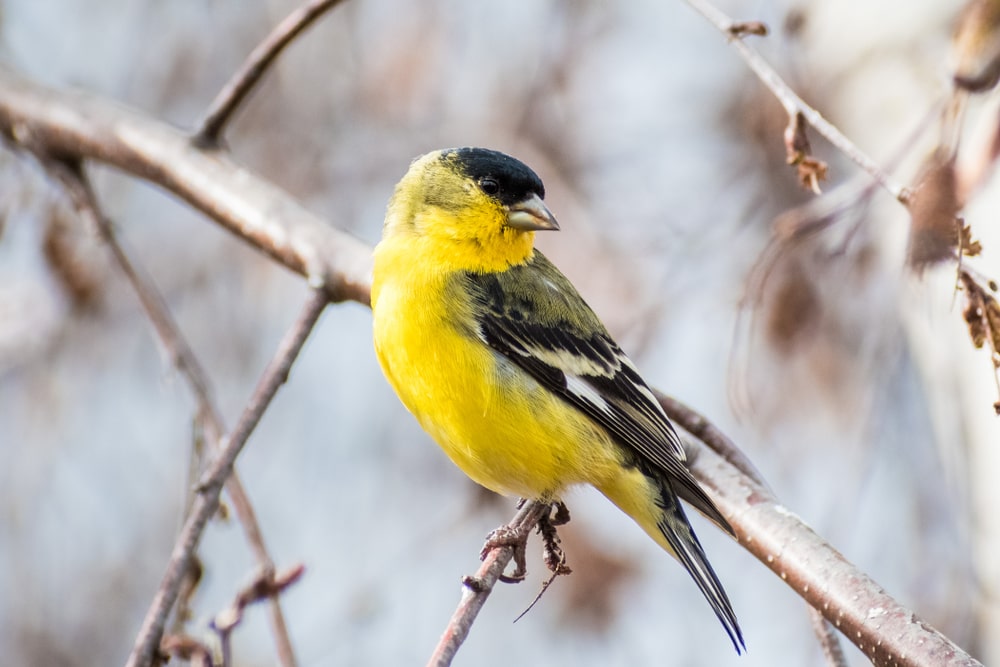
Between 3 1/2 to 4 inches (9 to 10 centimeters) in length, the vibrant Lesser Goldfinch is giving all the other Colorado finches a run for their money. How cute! Males’ features vary between a black back and a green back. Both have a black crown, white markings on black wings and tail, with some yellow. Females are similar to American Goldfinches but smaller, with dark rumps.
Lesser Goldfinches live in open woods, wooded streams, and gardens. Have you guessed what they eat? Mostly seeds but some Insects. They favor seeds from daisies, thistle, wild sunflowers, and seeds of various weeds.
25. Mountain Chickadee (Poecile gambeli)
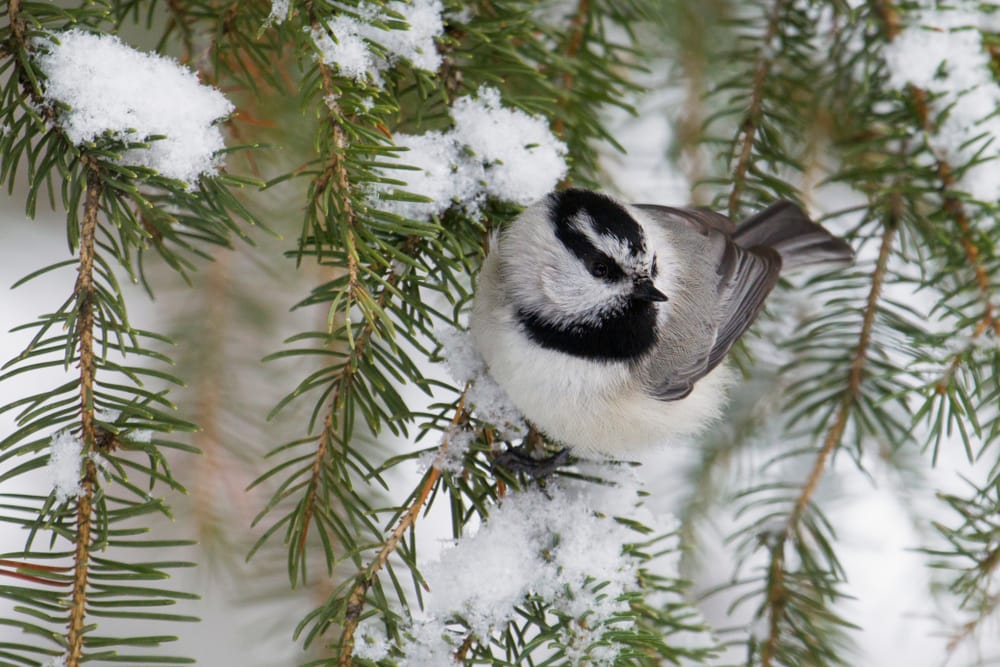
The Mountain Chickadee is typically found, well, in the mountains. This 5 to 5 ¾ inch (13 to 14.6 centimeters) birdie is almost identical to the Black-capped Chickadee, but with white eyebrows and pale gray sides. They are frequently seen darting from tree to tree in coniferous forests, searching for insects, spiders, seeds, and nuts.
Mountain Chickadees nest in cavities that they excavate from soft wood. They tend to, however, rely on holes made by other birds. They also nest in natural crevices, in nest boxes, and occasionally on the ground among roots.
26. Peregrine Falcon (Falco peregrinus)
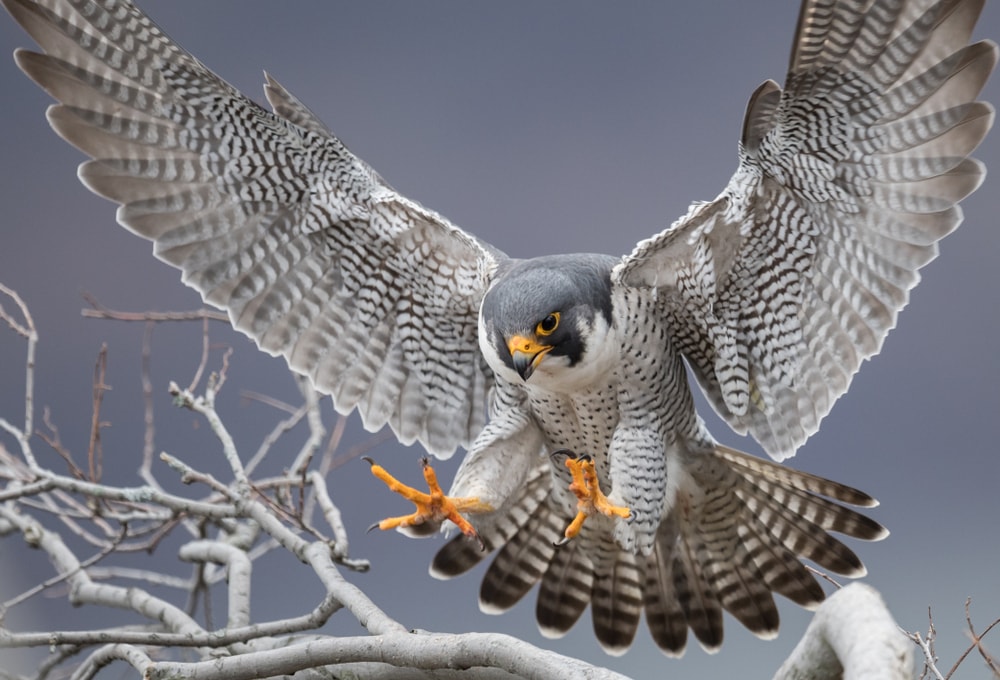
Peregrine Falcons in the eastern part of Colorado are migratory but remain permanent residents in western Colorado. This is a robust falcon with a black hood and wide black beard. Adults are generally slate-gray on top and pale below, with fine black stripes and spots. Its average length is between 15 and 21 inches (38 and 53 meters).
This raptor will prey upon small rodents, smaller birds, and mammals. What’s impressive is that Peregrine Falcons hunt in pairs to double-team a prey bird, confusing it and increasing their chances of making a kill.
These birds of prey inhabit open spaces with high cliffs and bluffs overlooking rivers and coasts. These territorial predators mate for life and once territory is established, it is defended by the pair. They prefer to nest on high cliffs but some of them have built nests on ledges of skyscrapers.
27. Prairie Falcon (Falco mexicanus)
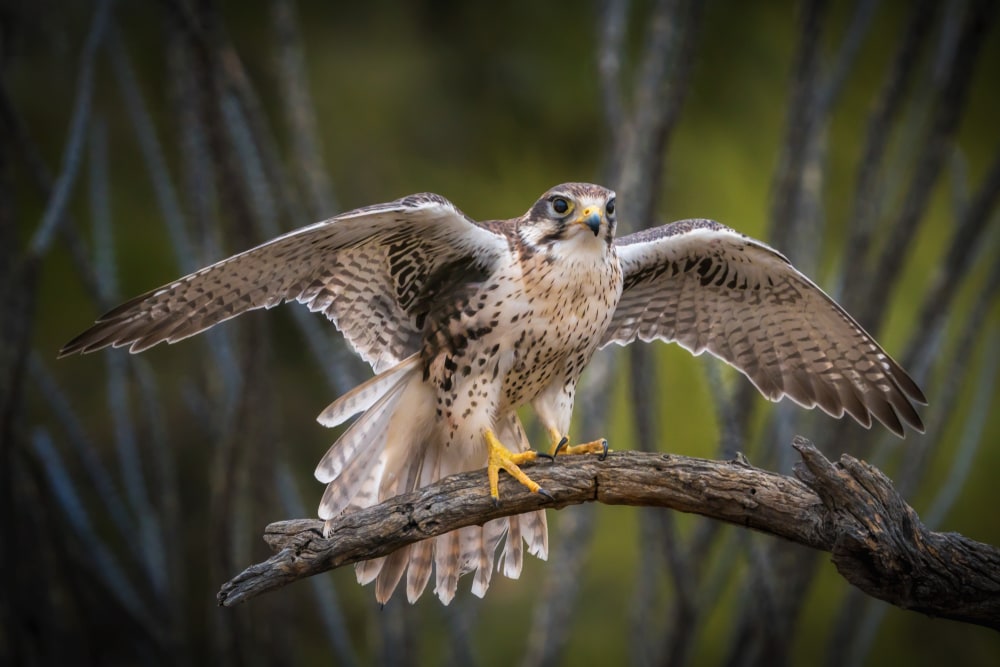
A Prairie Falcon is mostly brown, lighter underneath, with fine spots and streaks. One of its distinctive features is its narrow brown mustache stripe. This bird’s average length is about 20 inches (51 centimeters).
The best location for spotting one of these magnificent creatures is on open hills, plains, prairies, and deserts. As well as in open country above treeline high in the mountains. In winter, it is often found in farmland and around lakes and reservoirs.
Local residents keep all small pets safe inside the house. A Prairie Falcon’s diet consists mostly of small birds and mammals but it’s not surprising to catch one indulging in lizards and insects. It rarely nests on trees but instead on a ledge of a cliff, on a dirt bank, and sometimes uses an abandoned nest of a raven or hawk.
28. Red-Tailed Hawk (Buteo jamaicensis)
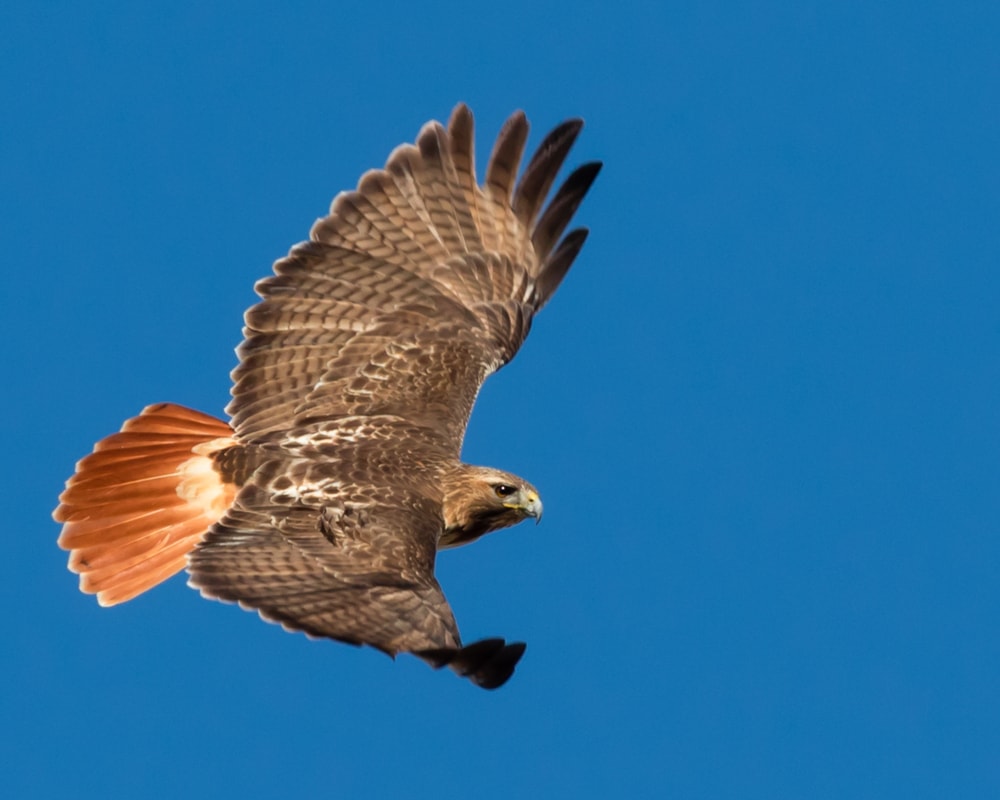
Red-tailed Hawks are often seen throughout the year in Colorado, but during severe winters, resident hawks may move to lower elevation areas. They can reach a length of 18 to 25 inches (46 to 64 centimeters). Light brown birds with light breasts and a rusty-colored tail. Though their color varies, especially in the West, where some are more black.
Small mammals, birds, reptiles, amphibians, and dead carrion are all part of this raptor’s diet. With incredible eyesight, you might be able to spot a Red-tail’s nest about 120 feet (37 meters) up in a tree. Will also nest on cliff ledges, among arms of giant cactus, or artificial structures. The nest is built by both sexes.
29. Red Crossbill (Loxia curvirostra)
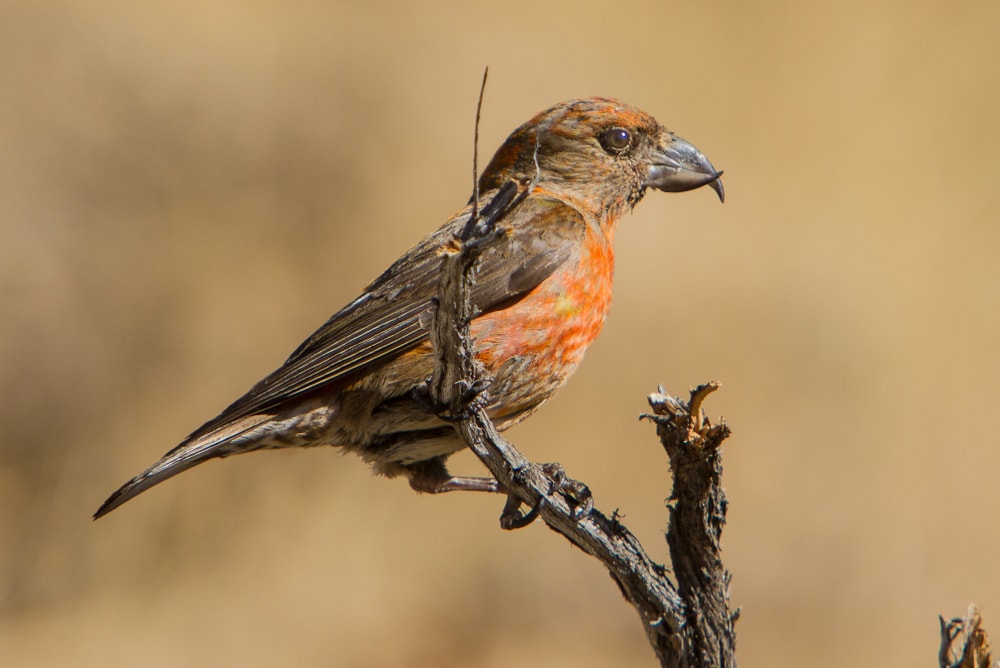
The sparrow-sized Red Crossbill is decorated with mandibles crossed at tips. Males are dusky brick red and females are gray tinted with cloudy green. This bird averages a length between 5 ¼ and 6 ½ inches (13.33 and 16.5 centimeters).
Look for them inhabiting mature conifer forests, western hemlock, Ponderosa pine, lodgepole pine, Sitka, and Engleman spruce. Conifer seeds make up the main diet of Red Crossbills but will often feed on the buds of trees, weed seeds, berries, and some insects and aphids.
Their breeding cycle is influenced more by food availability than the season. They can breed at any time of year. The nest is located on a horizontal branch high up in a conifer tree.
30. Rock Pigeon (Columba livia)
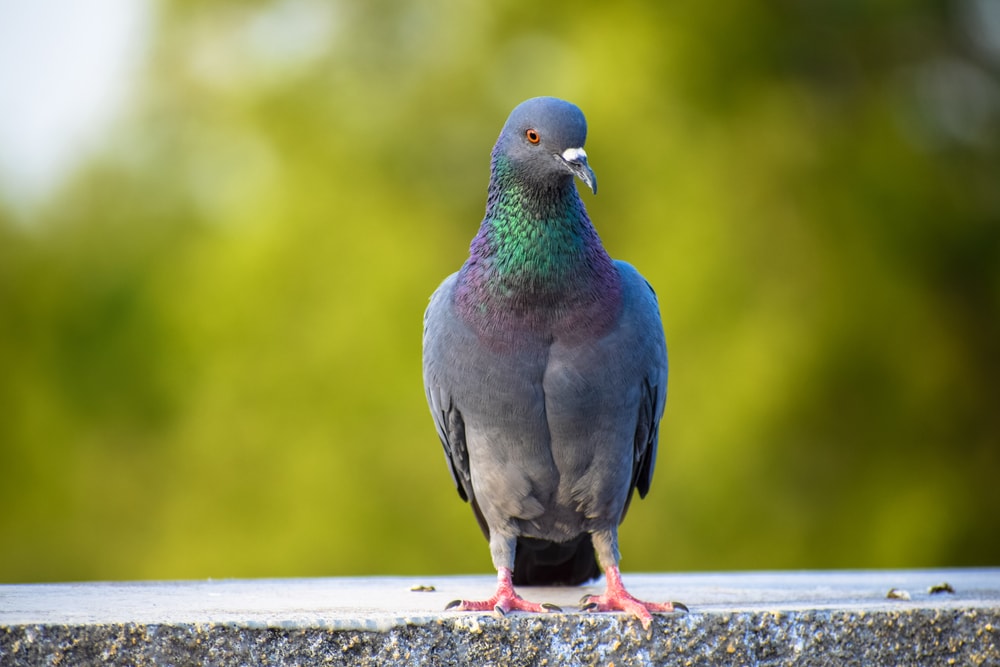
We’ve introduced you to finches, hawks, falcons, chickadees, and now Rock Pigeons. One place you can always see this common city Rock Pigeon is in the capital, Denver. This blue-gray bird has 2 narrow black wing bands and a broad black tail band. There are many color variants but this is the most often seen.
On average they will reach 13 ½ inches (34.3 centimeters). Though their name implies something different, these birds are doves. They will eat just about anything including seeds, grain, grass, berries, acorns, worms, insects, bread crumbs, and even popcorn. But it’s highly advisable not to feed them.
Their nests are everywhere in the city, around buildings, on window ledges, barn lofts, rain gutters.
31. Sharp-Shinned Hawk (Accipiter striatus)
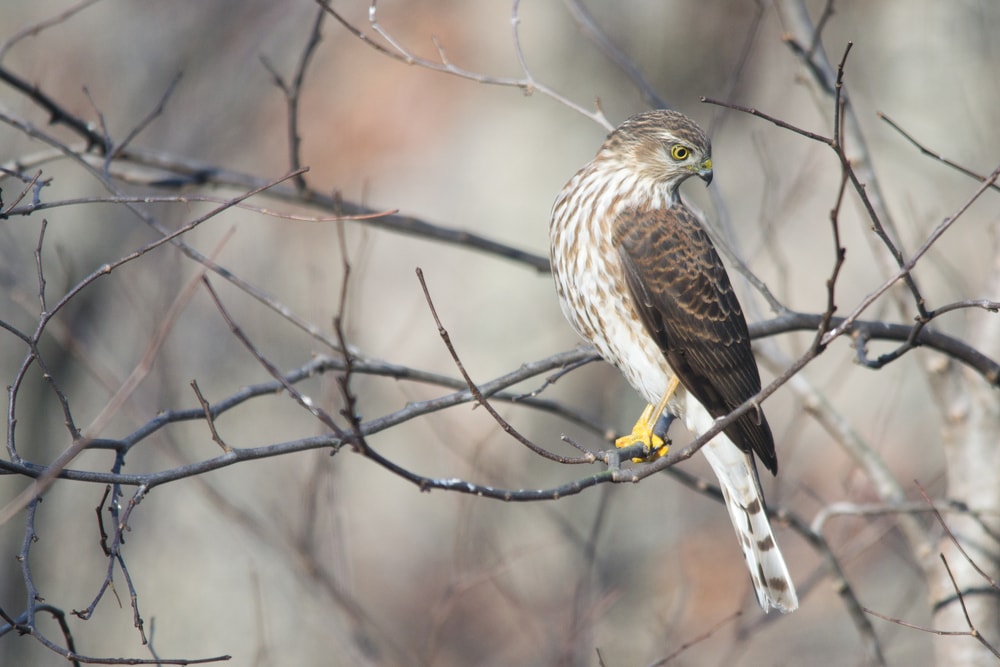
Sharp-shinned hawks are small for a bird of prey and are roughly between 10 to 14 inches (25 to 35 centimeters) long. It has a narrow, square-tipped tail and short rounded wings. Adults’ coloring varies from young ones and tends to be slate-gray and pale below, with fine rust-colored barring.
They will stay up in the Colorado mountains during the spring and summer and fly down to the plains for the winter. They typically return to the same territory every year to breed but rarely use the same nest more than once. Generally speaking, they avoid the open country.
They like to inhabit mixed or coniferous forests, open deciduous woodlands, thickets, and edges. Nests can be seen in groves of coniferous trees, in dense deciduous trees, or pure coniferous forests.
They eat small birds, small rodents, and species such as bats, squirrels, lizards, frogs, snakes, and large insects.
32. Steller’s Jay (Cyanocitta stelleri)
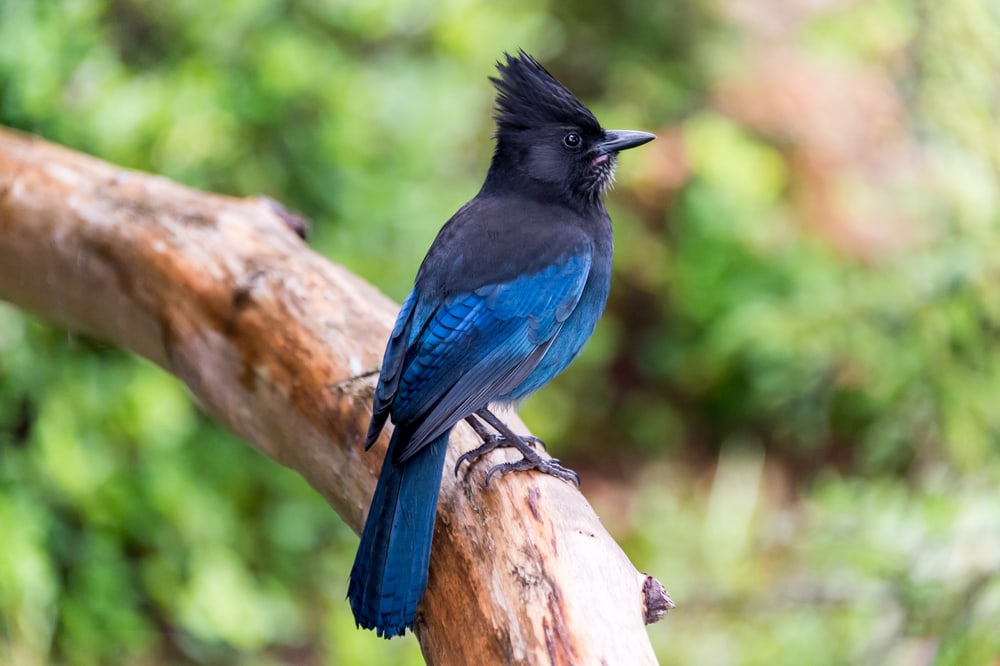
The 13 inch (33 centimeters) bird the Steller’s Jay is a truly beautiful bird. It’s known as the only western jay with a crest. The front half of this specimen is dusty black, with a dark blue-gray rear, and tight black cross barring on its tail. When light hits it just right, its hues of blue become iridescent.
It’s a permanent resident of the mountains but may move to lower elevations in winter. Its diet is made up of two-thirds vegetable and one-third animal matter. It will feed on pine seeds, acorns, and nuts. A Steller’s Jay nest is most often built high in trees.
33. Townsend’s Solitaire (Myadestes townsendi)
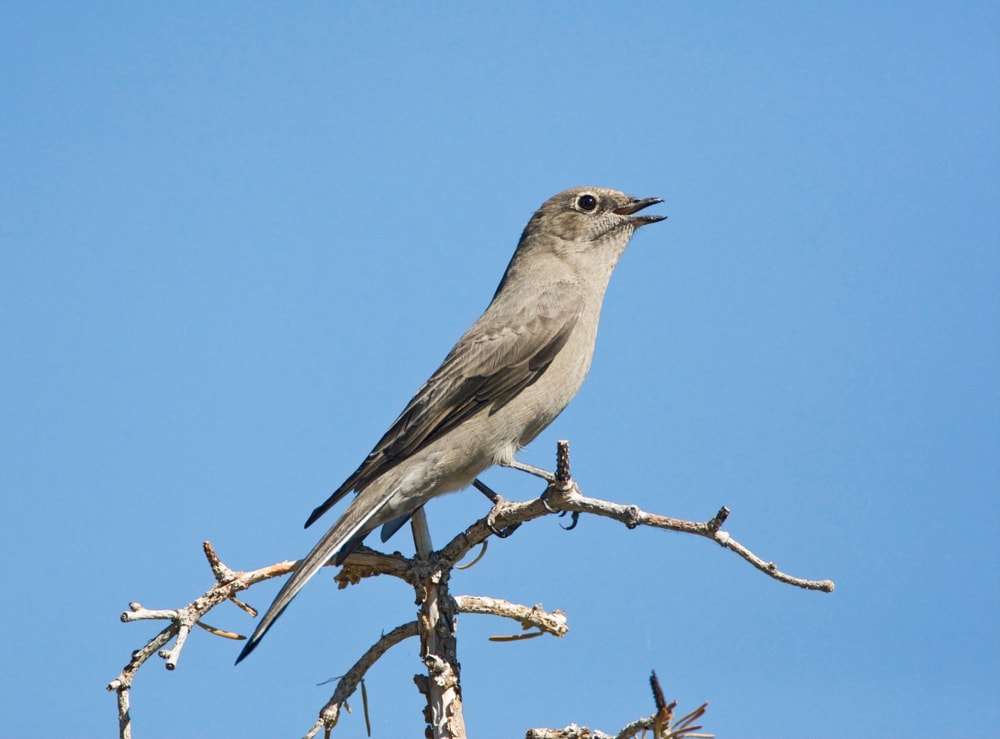
A slender gray-colored bird that reaches a length of about 9 ½ inches (24 centimeters) and resembles a mockingbird. It’s a solid gray all over, but slightly darker on top. The Townsend’s Solitaire is found in steep banks for nest sites and open forests where it catches prey.
This bird has two diets determined by the seasons. In winter, it will eat mostly berries and in the summer, it will indulge in insects. They are ground-nesters and will nest in any spot that’s protected on the ground, including cliff crevices, under a stump or log, or amid upturned roots.
34. Woodhouse’s Scrub Jay (Aphelocoma woodhouseii)
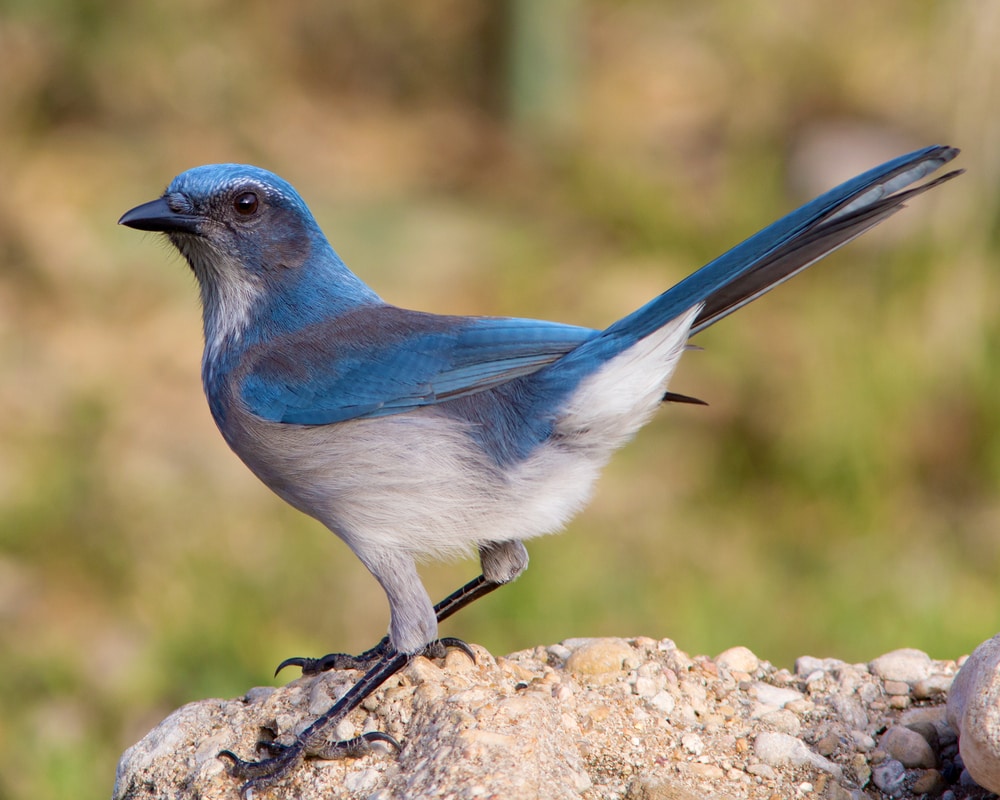
Giving us a break from the gray birds is the Woodhouse’s Scrub Jay, related to crows and magpies. Its length is between 11-12 inches and weighs just under three ounces. Primarily all blue, it has a brown back with light gray underparts. They look a lot like the Western Scrub Jay.
Look for these blue birds inhabiting areas of low scrub, pinyon-juniper forests, oak woods, edges of mixed evergreen forests, and sometimes mesquite bosques. They are very common west of the southern Rocky Mountains and can be found in scrub-brush, boreal forests, and temperate forests. They feed on frogs, lizards, eggs, nestlings of other birds, insects, grains, nuts, and berries.
35. White-Breasted Nuthatch (Sitta carolinensis)
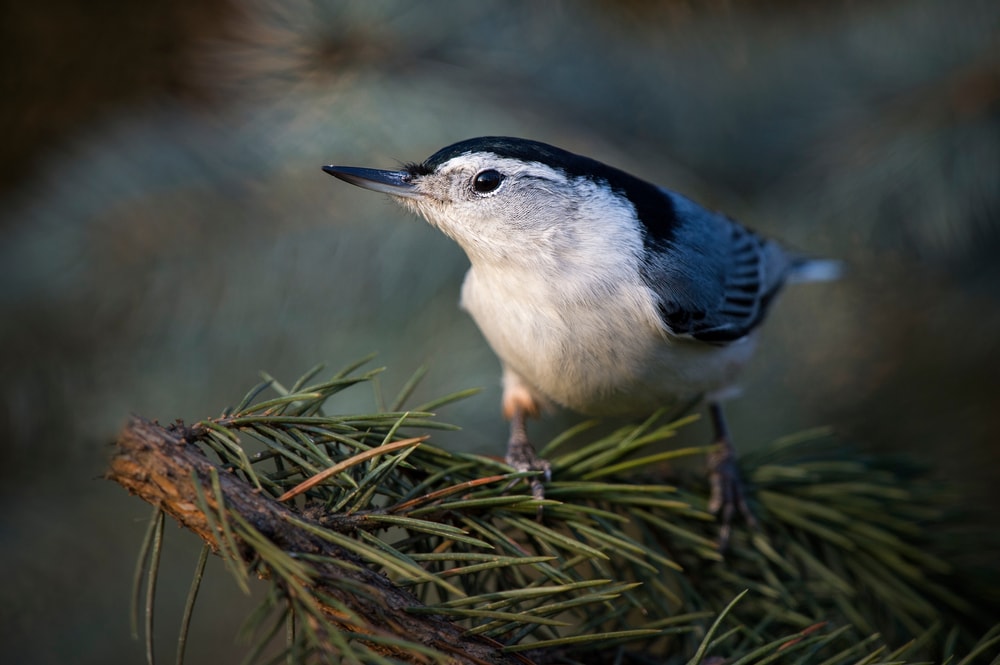
The White-Breasted Nuthatch is distinguished by its blue-gray coloring with white underneath and face, and the black striped crown on its head. Growing between five and six inches, this small bird.
You can find this species nesting and living in forests, groves, and shade trees, favoring woodland edges, along rivers, roads, and clearings. In short, it likes large trees. Seeds and insects make up this simple eater’s diet.
36. Lark Bunting (Calamospiza melanocorys)
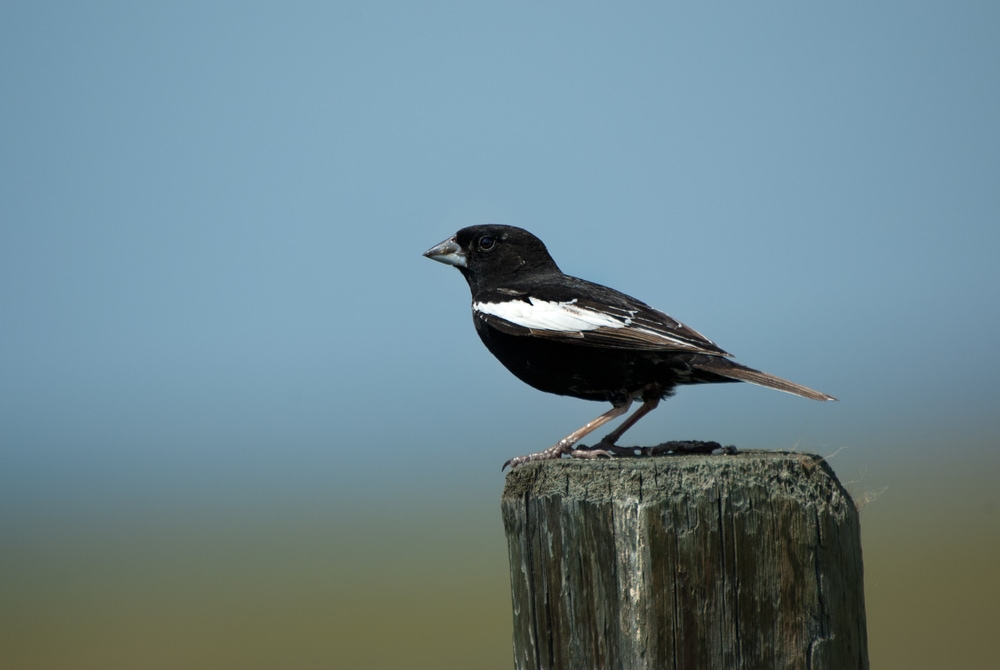
The Lark Bunting isn’t a permanent resident of Colorado, but it’s the state bird, making it necessary to give it a shout-out. Hey Lark Bunting! It will breed on shortgrass prairie or sagebrush. After which it will gather in a flock migrating south. They have been spotted in open lowlands and as high as 12,900 feet. Quite the feat for such a small bird.
Lark Bunting’s feed on insects, mainly grasshoppers. They flush prey from grass by running or hopping on it. During migration and in winter, they’ve been known to gather in large flocks to collect seeds, grain, and cactus fruits.
This mostly black bird is identifiable by the white stripe on its wings. It’s 5.5-7.1 inches in length, weighing approximately 1.5, and has a wingspan between 9.8 and 11 inches.
You May Also Like: There Are 30 Adorable Types of Ducks You Should Definitely See with Photos, Cute Infographics, Facts, and more!
Interesting Facts About Colorado Birds
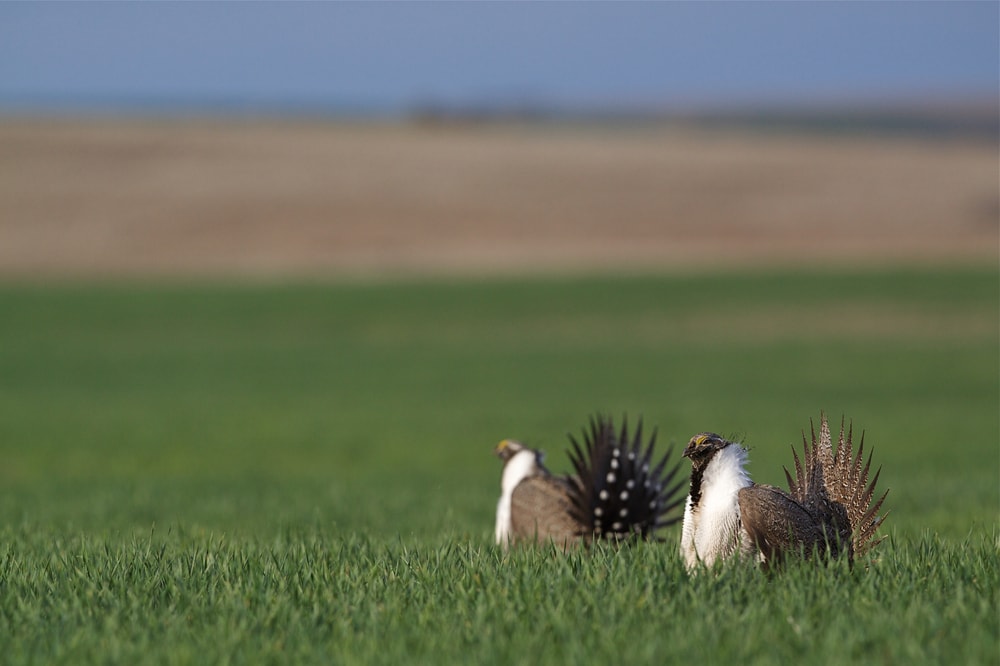
The rarest bird in Colorado is the Gunnison Sage Grouse
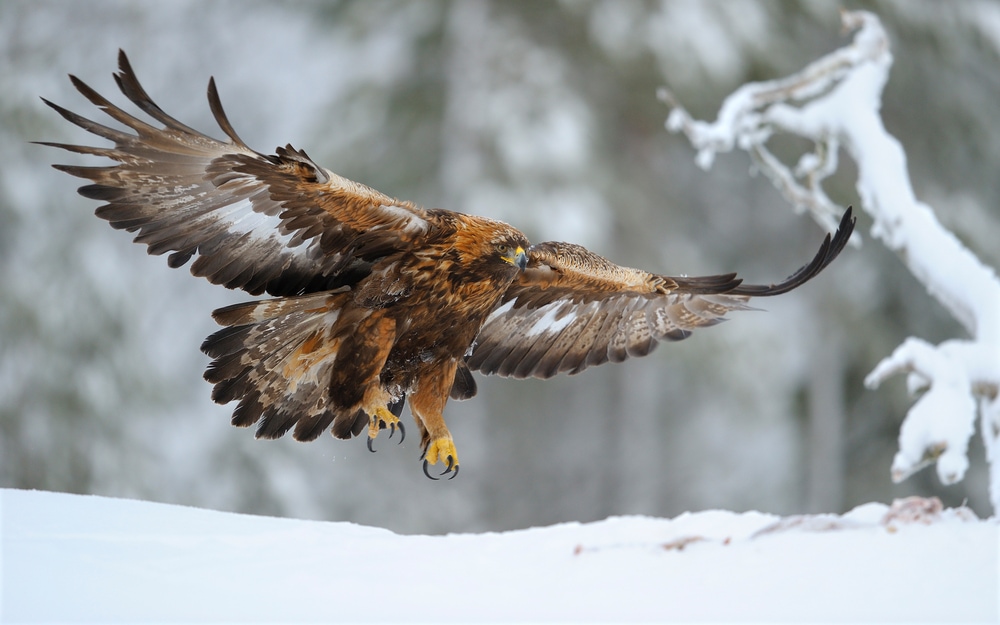
The Golden Eagle is a bird of prey and is the largest bird in Colorado

Though a migratory bird, the Broad-Tailed Hummingbird is one of the smallest birds seen in Colorado
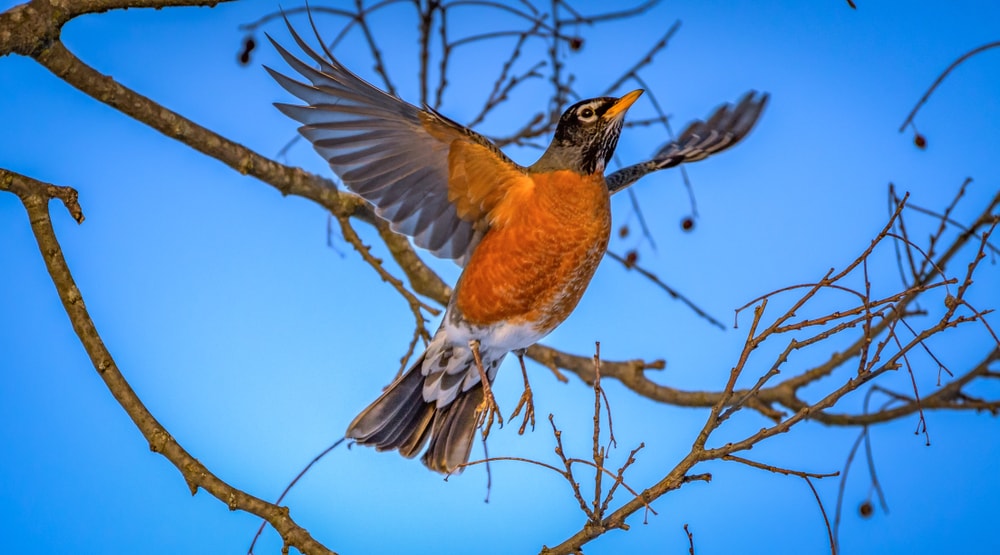
The American Robin is voted the most common bird in Colorado
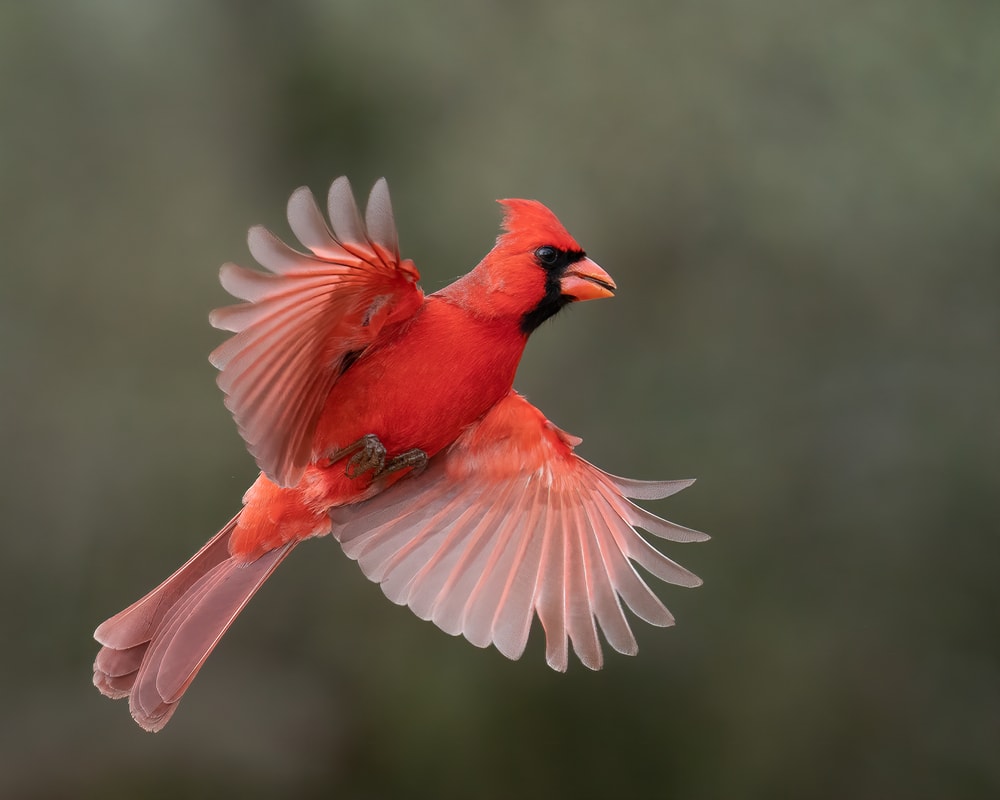
Cardinals are considered rare in Colorado
You May Also Like: Discover These Over 300 Different Types of Doves with Photos, Infographics, Facts, and more!
Colorado Birds Are Remarkable
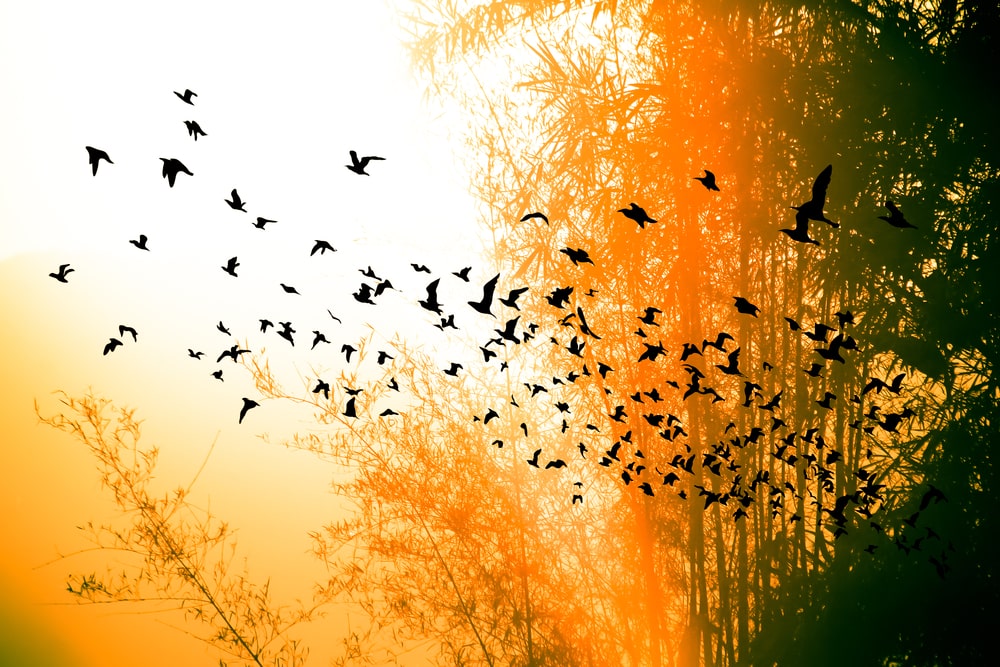
With several hundreds of birds living in and migrating through Colorado, it’s impossible to pay homage to them all. This list comprises all the known birds that call Colorado their permanent home. As global warming continues and impacts climate change, more and more bird habitats along with the number of non-migratory birds in Colorado are likely to change.








